Costa Rica 2010 Trip Report
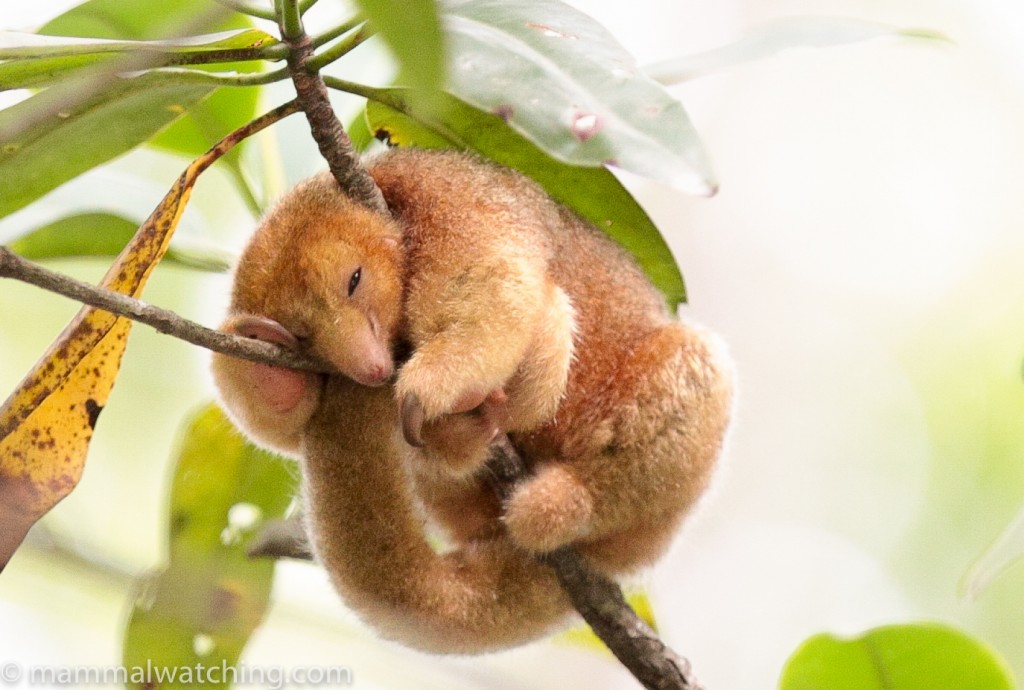
Silky Anteater, Cyclopes dorsalis, Manuel Antonio
I first bought a guide book for Costa Rica in 1996, but for various reasons that I cannot remember, though which probably had something to do with my ex-wife’s belief that the only good vacation was one in Scotland with her parents, I didn’t get there until February 2010.
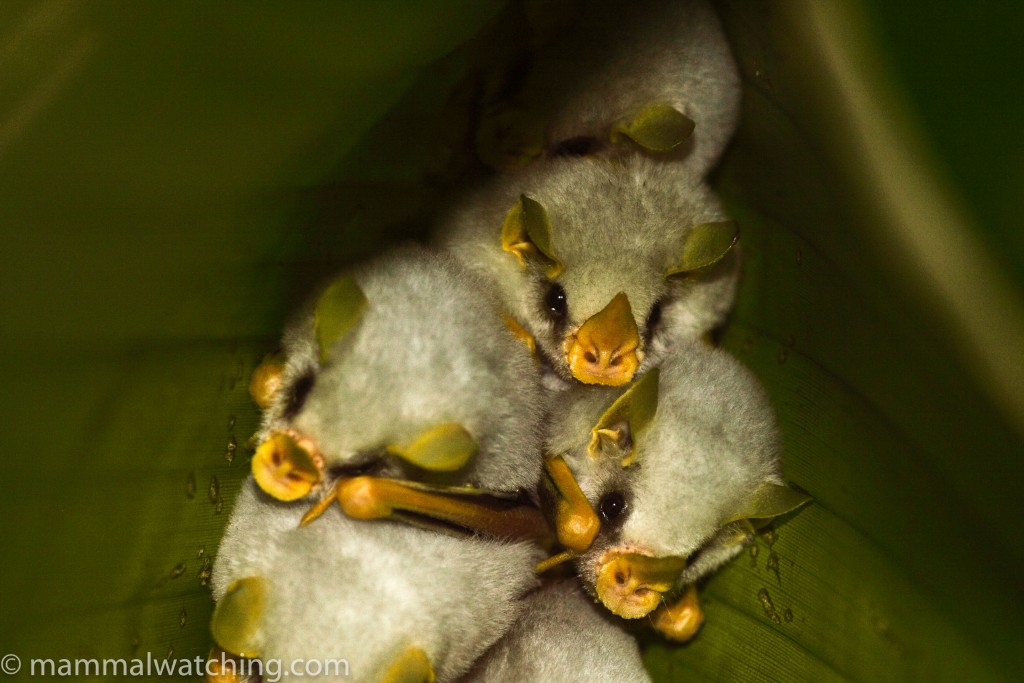
Honduran White Bats, Ectophylla alba, Tirimbina
Some Observations
Costa Rica is an interesting country: in 2010 they topped the New Economic Foundation’s Happy Planet Index because of their long life expectancy (longer than the USA), happy population, and low ecological footprint. In other words they seem to live long and happy lives without stuffing up their environment.
I wont go into why they live long environmentally friendly lives. But I will speculate on their happiness. It may have something to do with all the mammals that can be found very easily there, or the general friendliness of the people. But it most certainly doesn’t have anything to do with the quality of Costa Rican signposting or direction giving. I got lost on every trip I took: signposts would frequently point simultaneously in opposite directions for the same location or would appear regularly to lull you into a false sense of security and then, 1km down the road at a 4 way intersection, just disappear. Maps were not very helpful. And when you asked someone for directions it would usually involve the answer “directo” and “no problemo”, and omit to mention that after 1 km of directo there would be a fork in the road. Ah well…. I will try not to think about the hours I wasted.
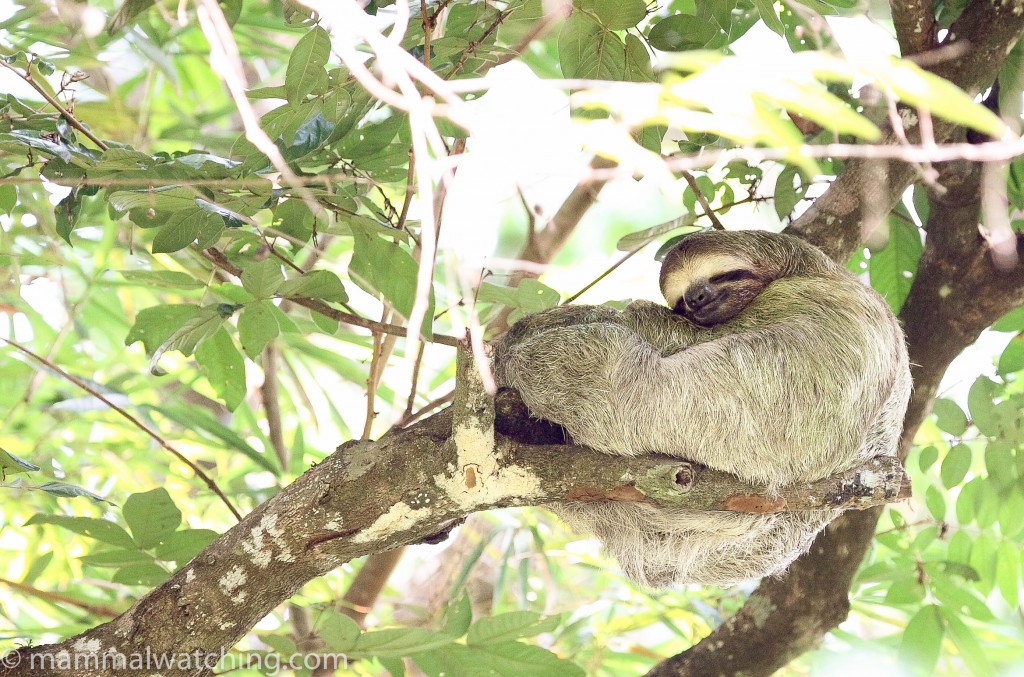
Brown-throated Three-toed Sloth Bradypus variegatus, Manuel Antonio
The main roads were pretty good and I drove more recklessly than any of the Costa Ricans. The minor roads were slow (and badly signposted!) so it was usually much quicker to avoid “short cuts”. The food was very good, the weather in February was almost perfect and most of the Ticas (Costa Ricans) I met – outside of the Osa Peninsula – were really good people. The mammals were prolific.
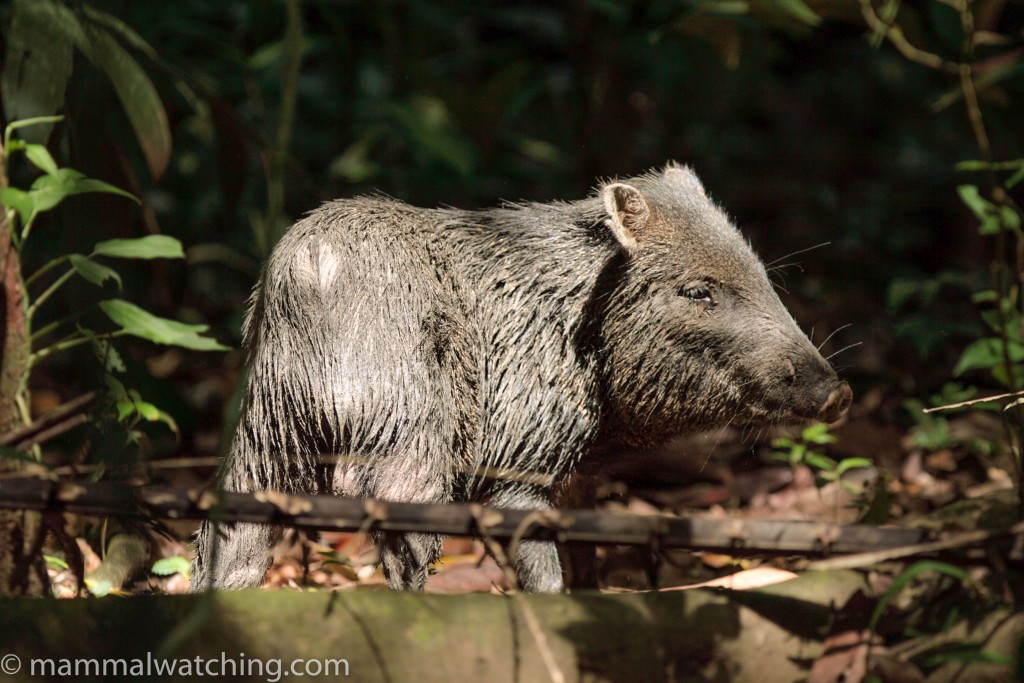
Collared Peccary (Javelina), Dicotyles tajacu, Corcovado
I organised the trip myself, other than in Corcovado where I made the mistake to using one of the local tour operators: Carlos Gonzalez, from Corcovado Expeditions. He was efficient only at extracting money from me and the little information he gave was, it turns out, misleading. Don’t use him.
Corcovado and the Osa Peninsula
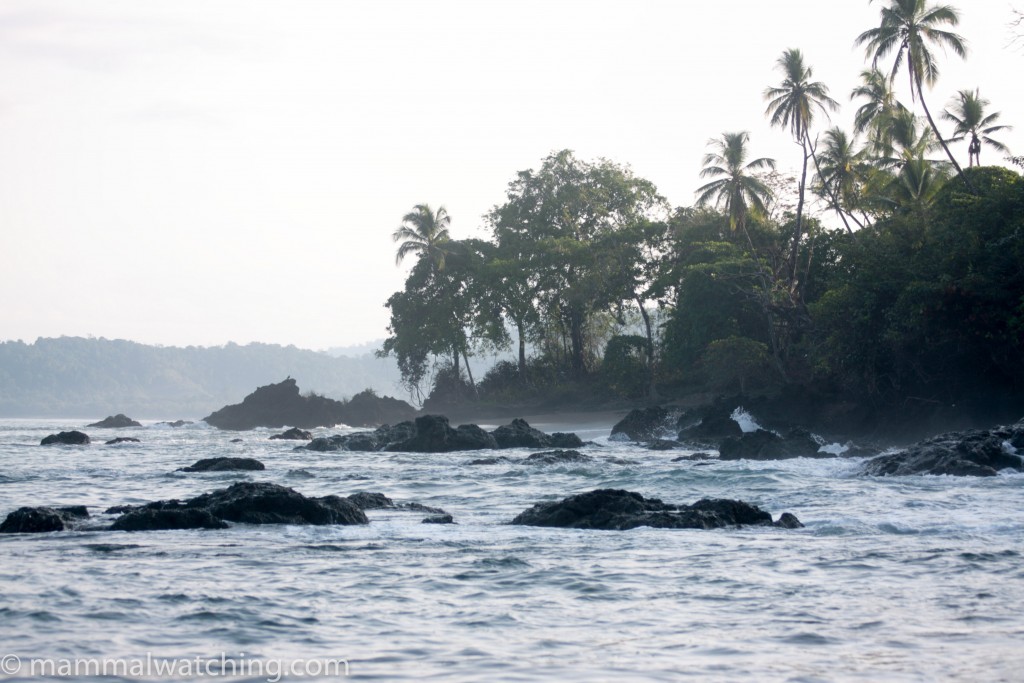
I had hoped to leave San Jose at 8.30 a.m. on my first morning and then drive five hours to the town of Sierpe to catch a boat to Drake Bay on the Osa Peninsula. But Budget were two hours late delivering my rental car (not uncommon apparently), and then I got hopelessly lost trying to get onto the highway south, because I made the mistake of assuming my Costa Rican co-pilot knew where she was going. So I missed the boat and had to spend the night in Sierpe. I stayed at the Estero Azul Lodge. This was a pleasant hotel and in the morning there were White-faced Capuchins (split by IUCN in 2015 to Cebus imitator from Cebus capucinus) in the gardens, a species I later missed in Corcovado. There were also a few Red-tailed Squirrels. Common Opossums are sometimes seen at night there though I didn’t go looking.
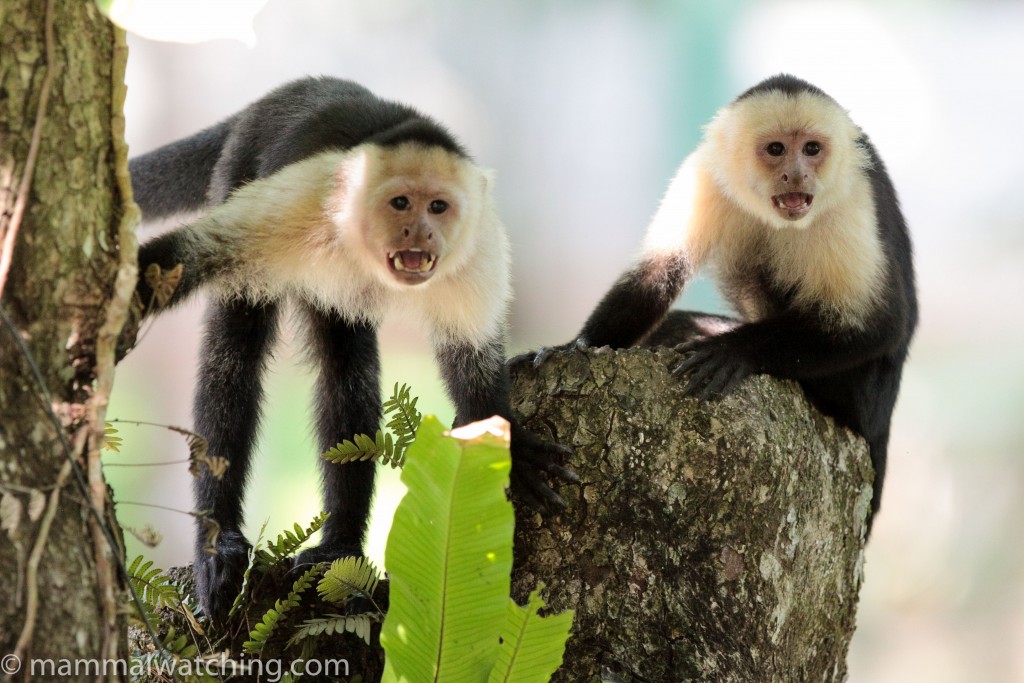
Panamanian White-throated Capuchin, Cebus imitator
Corcovado is probably the best place for larger mammals in Costa Rica. And Sirena Station is probably the best bit of Corcovado. To get there you can either fly in by light aircraft, which is probably quite cheap if there is space on a plane already going though I didn’t look into this; take a boat from Drake Bay; or hike 16 km from the nearest road. If you were walking in during February the heat and high humidity would not be pleasant.
I took the boat from Sierpe to Drake Bay the next day. Despite having paid for a private boat to Sirena Station, I had to spend the night in Drake Bay so I could catch one of the scheduled boats the next day. Apparently my private boat did not exist. If I go back I would organise it all from Sierpe or Drake Bay when I arrive. It would be much cheaper to do this at the last minute, and stories about the park filling up and reservations needed for campsites are, I suspect, untrue and put about by the likes of Carlos Gonzalez to extract money from the likes of me. Plenty of hotels run daily boat trips to Sirena so you could also get a lift on one of those and then camp. Arranging food in advance with the park might be more of a problem so it would be better to bring that with you.
Drake Bay is an ecosystem of annoyance. First, it is full of backpackers. Second, it is full of people whose mission in life is to extract money from backpackers. So business revolves around one group trying to do things as cheaply as possible, with another group attempting to extra money as cunningly as possible. For example, my luggage didn’t arrive with me on the boat because of some confusion at Sierpe when they moved my bags but didn’t tell me that I had to put them on the boat myself. The bags came on the later boat and someone on the beach tried to charge me $10 for the “delivery fee”. Even Air France don’t resort to such double dealing, though if they read this they may want to introduce this policy.
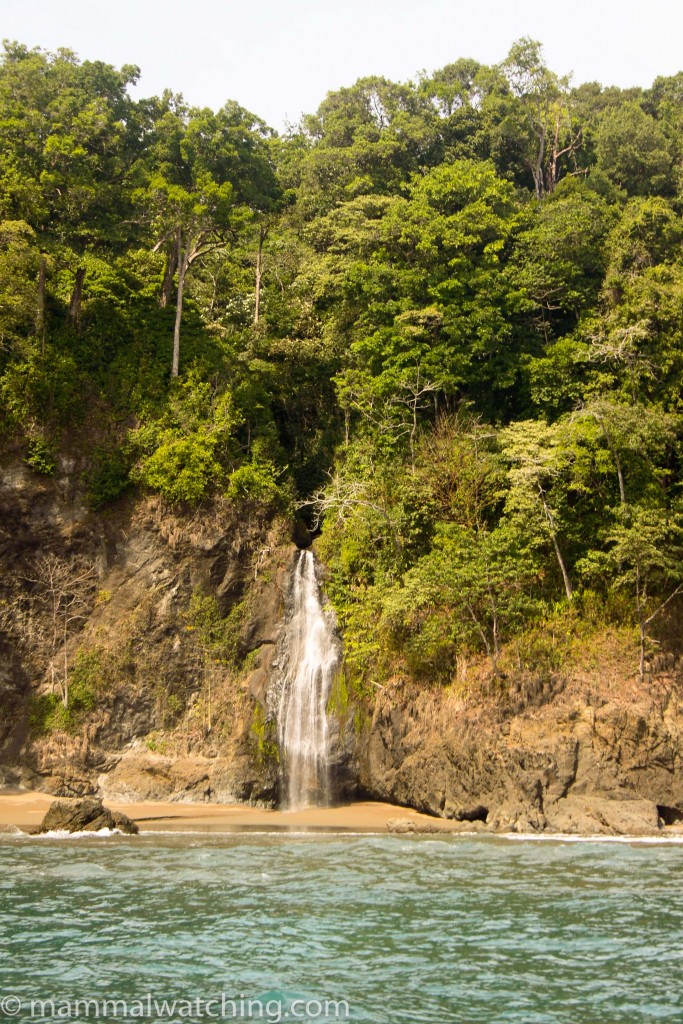
Waterfall on the beach near Drake Bay
I had booked a trip to Sirena with Carlos from Corcovado Adventures but he seemed to have subcontracted it to Corcovado Osa Expeditions, at least that is what I think they were called. I wouldn’t use either business either. The guide – Oscar – was pretty good and a nice guy, but I had to share him with other people despite promises to the contrary, plus the 6 a.m. departure they promised was 7.30 by the time the manager had woken up. I took a mammal-less guided night walk in Drake Bay along a creek where I heard what was probably am opossum feeding in a tree. The guide said he had seen a ‘Grey Water Opossum’ in the creek a few weeks earlier but I am not sure if he meant a Yapok or a Grey Four-eyed Opossum. I suspect the latter.
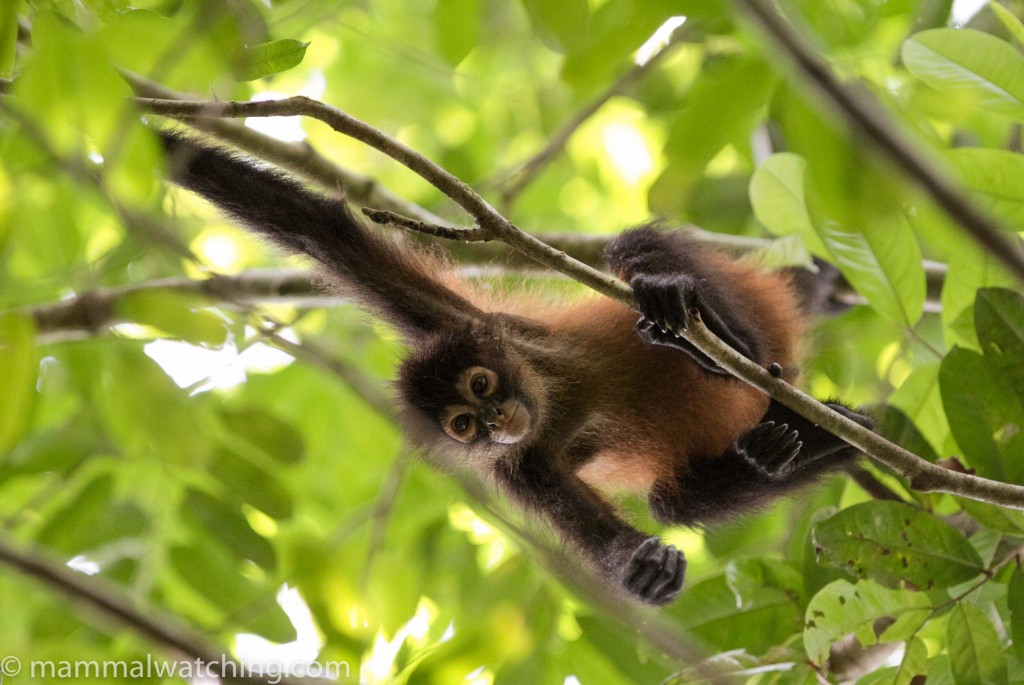
Central American Spider Monkey, Ateles geoffroyi
The best reason to stay in Drake Bay is probably to go whale watching. If I had had an extra day I would have gone out with Costa Cetacea. Shawn Larkin, the operator, seemed to know his stuff and some of the more interesting species he sees regularly include Rough-toothed and Spinner Dolphins, False Killers and Sei Whales.
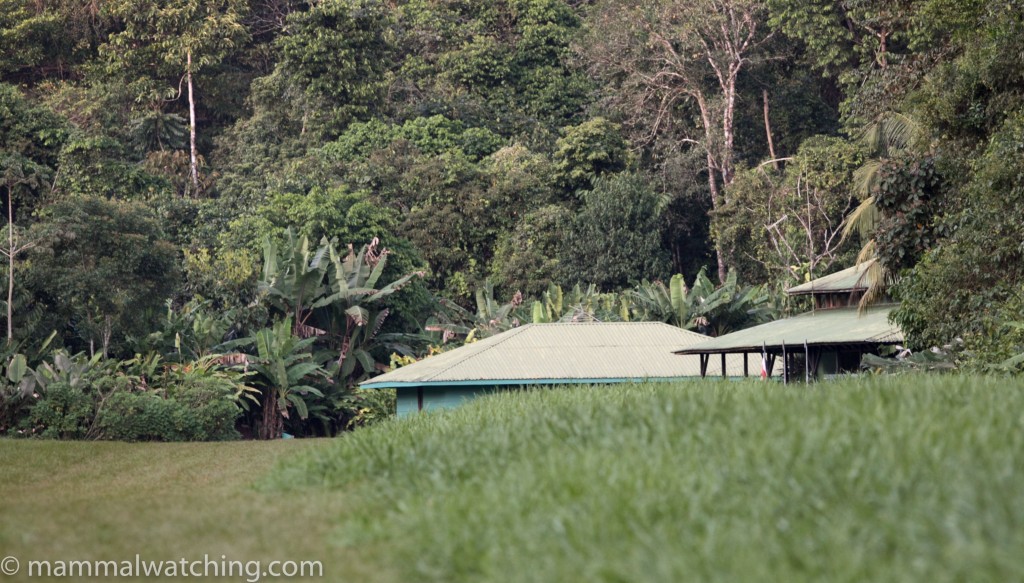
Sirena Station
Corcovado is another hour or so on a boat from Drake Bay.
I was dropped on the beach about a kilometre from Sirena Station, and the hike across the airstrip took me past several different primates.
I didn’t like the station itself. There were a lot of backpackers staying there, having a ‘one night in the rainforest’ adventure, it was stinking hot and impossible to sleep in a tent. There was a covered area where you could be more comfortable sleeping inside a mossie dome though the sleep you might gain from cooler temperatures would probably be offset by the snoring of a dozen tourists. The mosquitoes at Sirena were as bad as they get anywhere. Now I wouldn’t mind suffering all of this to be somewhere remote, but to have also to put up with another 40 people was annoying to say the least. So I only stayed one night.
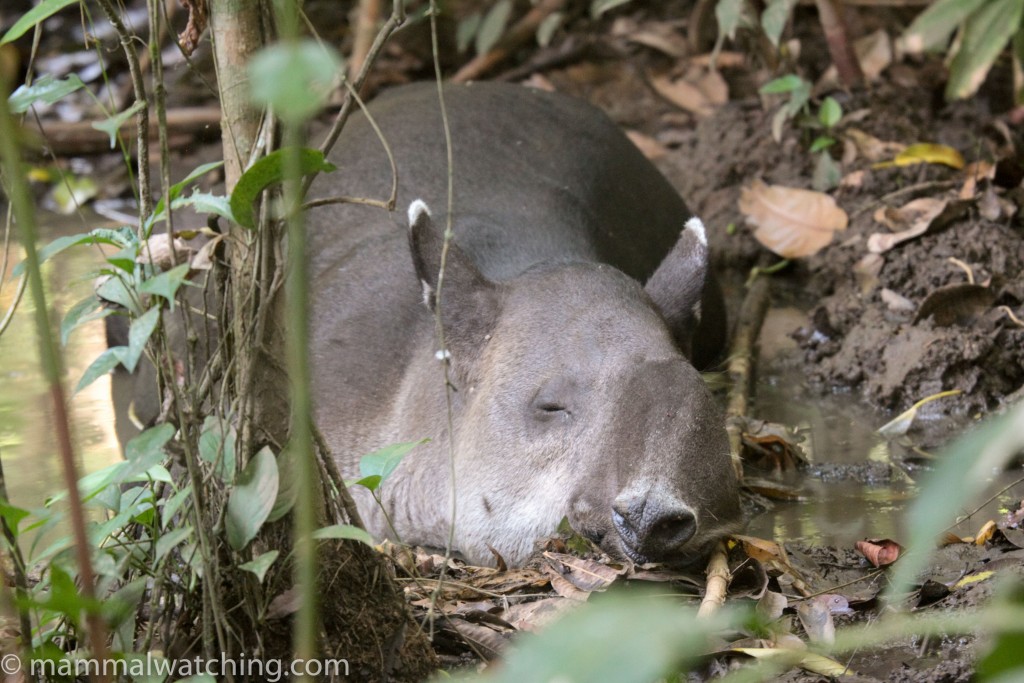
Baird’s Tapir, Tapirus bairdii
But the mammal watching was excellent. My main reason to visit was to see Baird’s Tapir and White-lipped Peccaries. Baird’s Tapirs are easy to find. The guides know where to look for them in the day, and Oscar found one in small mud hole just off the trail during the first afternoon. I saw another during a short solo night hike at 4 a.m., although night walks were not allowed officially anymore because of the risk from snakes. I saw one more the next morning. They were habituated and I got to within 4 metres of the first animal.
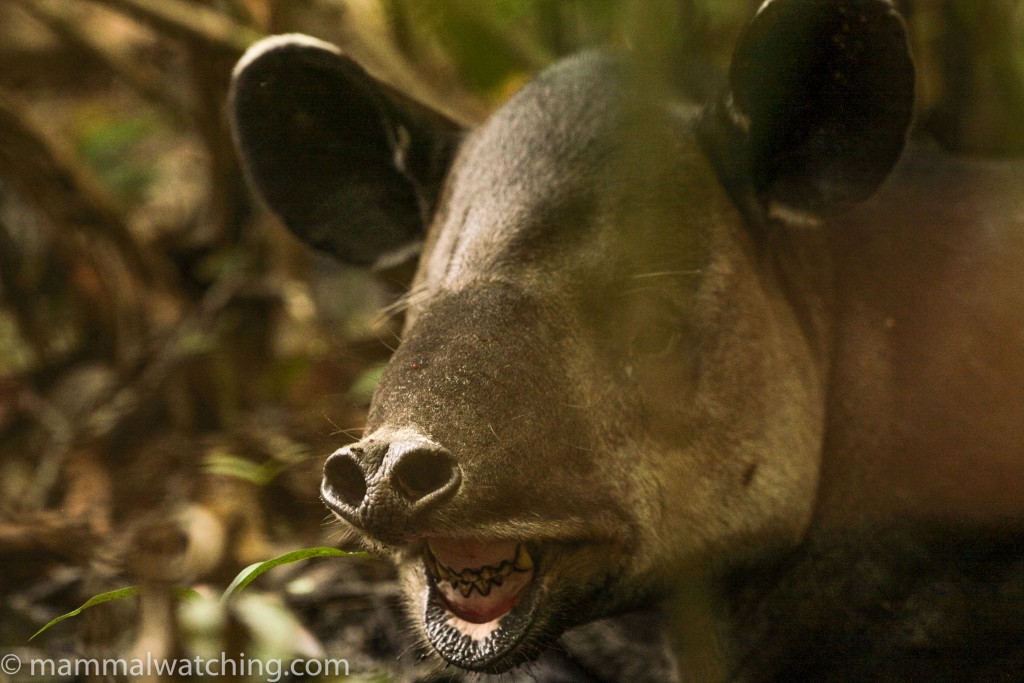
Baird’s Tapir, Tapirus bairdii
The White-lipped Peccaries were a bit harder to find but Oscar found a group of 60 or so animals during my second morning. It was an impressive sight, sound and smell to be in the middle of the sounder, with much teeth clicking. Happy with the peccaries I decided I would leave Corcovado for somewhere quieter where I might be able to sleep.
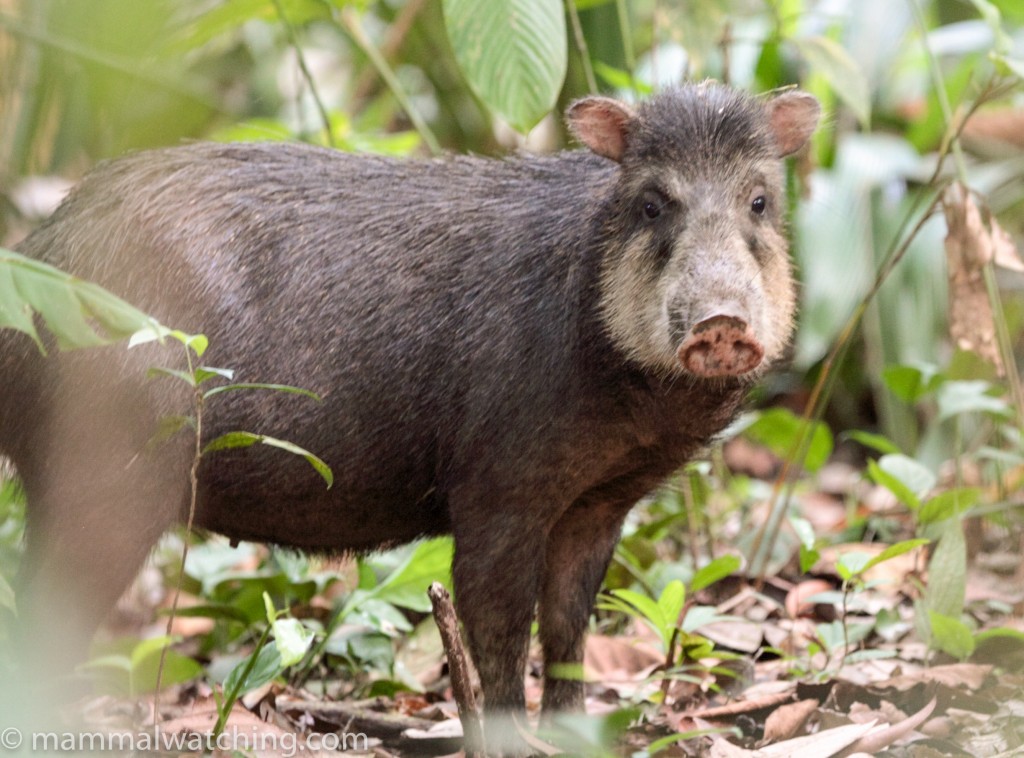
White-lipped Peccary, Tayassu pecari
Walking during my two mornings and one afternoon I also saw Collared Peccaries (harder to see than White-lipped apparently), a White-tailed Deer (apparently rarely seen) and Central American Spider Monkeys.
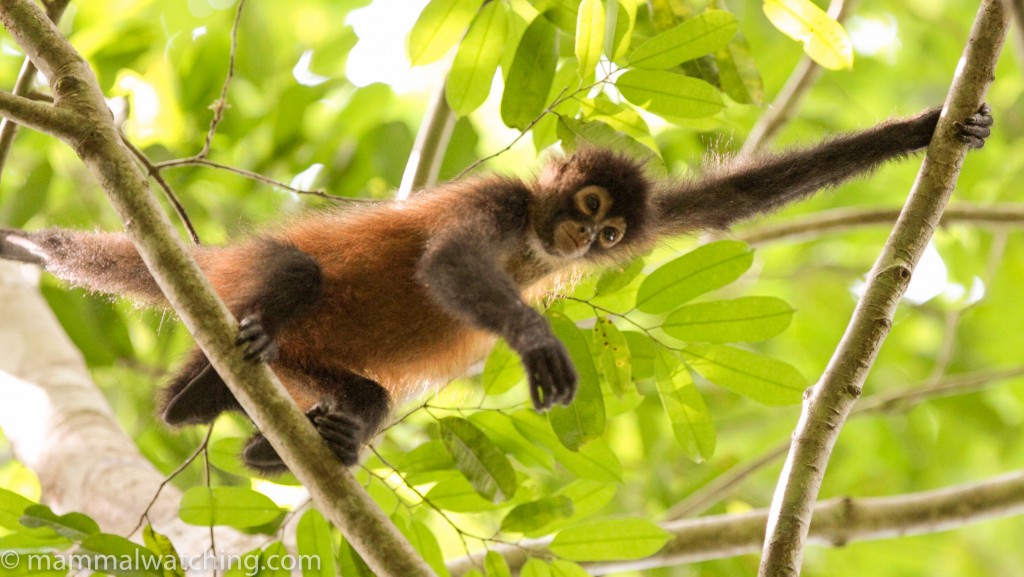
Central American Spider Monkey, Ateles geoffroyi
Together with Red-backed Squirrel Monkeys (in the forest along the airstrip), Mantled Howler Monkeys, two groups of White-nosed Coatis and some Long-nosed Bats
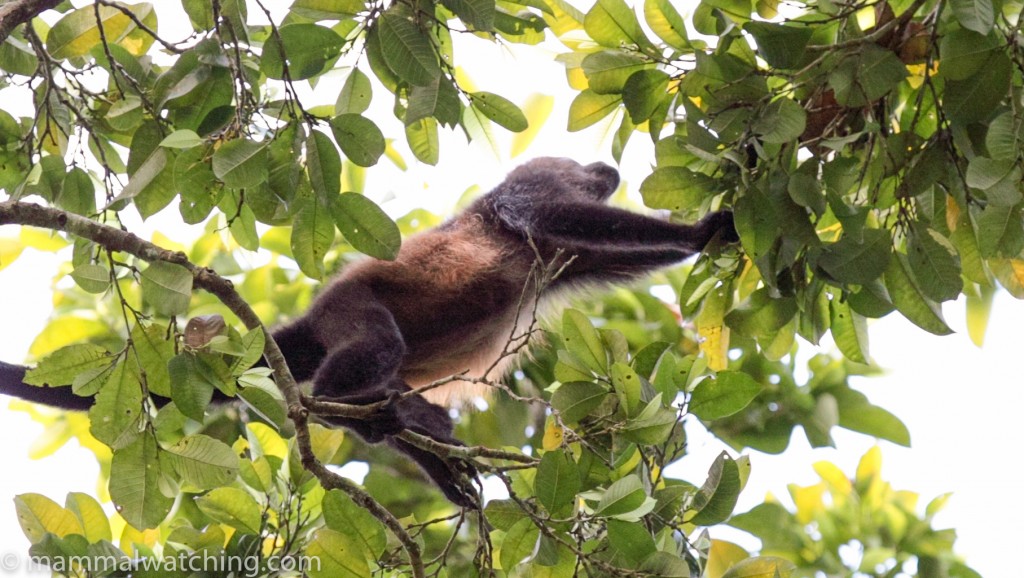
Mantled Howler Monkey, Alouatta palliata
I also found a Hoffman’s Two-toed Sloth, which are rarer than the three-toed flavour in the park, and spotted a couple of Tome’s Spiny Rats in the toilets at night, which appeared to be eating the used toilet paper…. yummmmm.
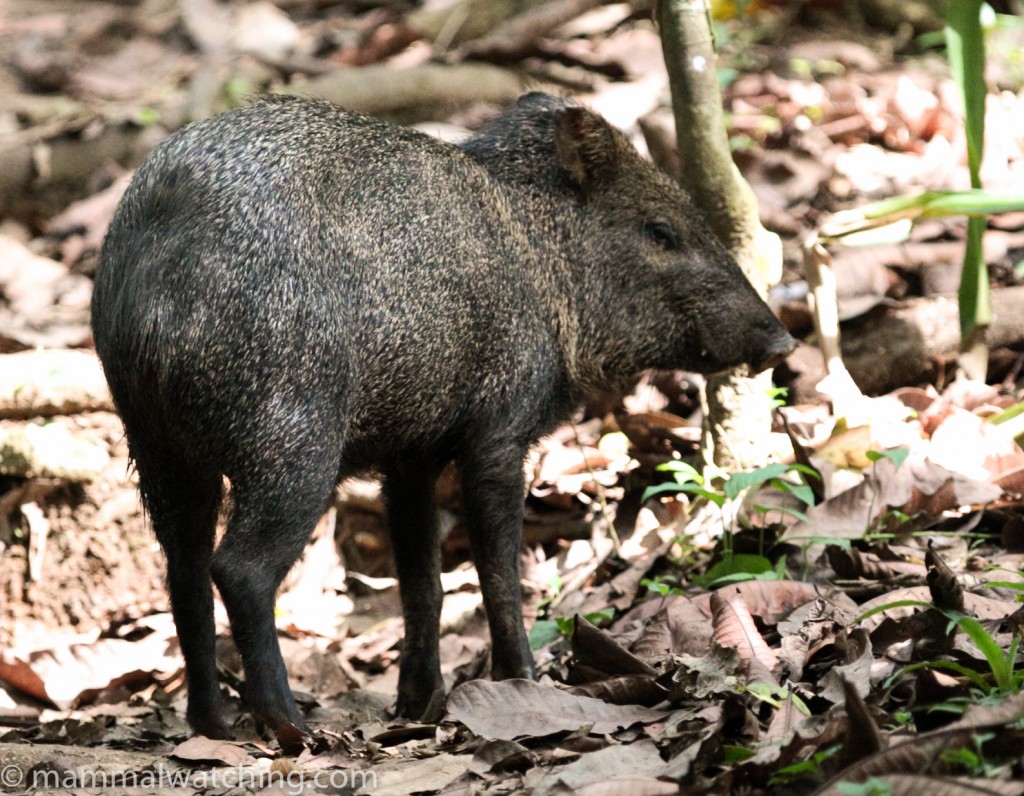
Collared Peccary (Javelina), Dicotyles tajacu
If I had stayed a bit longer I would probably have seen a Tayra, a Tamandua and Brown-throated Three-toed Sloth, as I guess all of these species are seen most days by some people there. Sightings of cats seems to be less frequent than they once were.
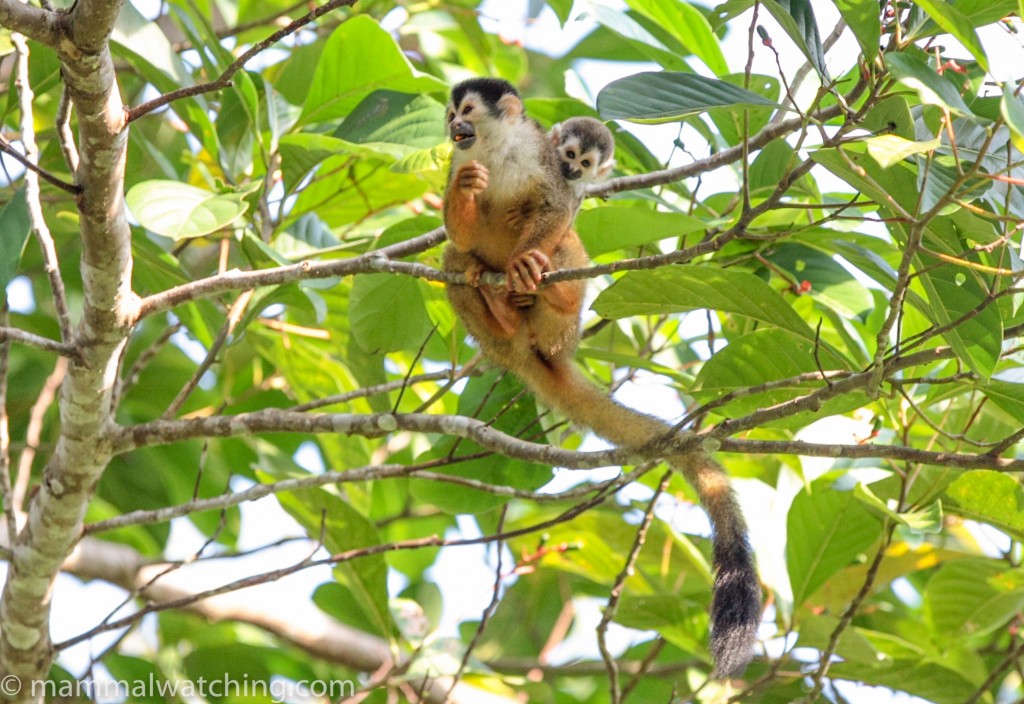
Red-backed Squirrel Monkey, Saimiri oerstedii
So an impressive list for such a short visit. Rainforest mammal watching does not get any better than in Corcovado. Not only are the mammals abundant, but they are easy to approach.
Manuel Antonio & Quepos
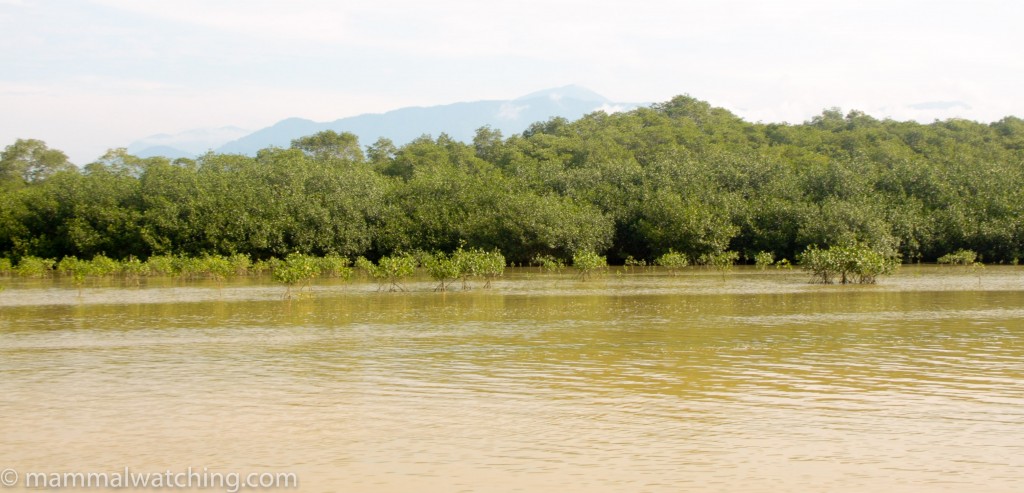
Manuel Antonio is a small but popular, hence overcrowded, national park, less than two hours’ drive from Sierpe, though it took another hour when I got there to find my hotel!. Squirrel Monkeys, White-faced Capuchins and Howlers are all easy to see here, even though I didn’t see or look for them, and Brown-throated Three-toed Sloths are abundant. I saw a couple in the park and a couple more from the terrace of a nearby hotel (I don’t remember the name but it was about 2 km before the park and has signs outside talking about the monkeys in the garden). There was also a tame White-tailed Deer hanging around the park entrance. My reason to visit here was because Jeroen Verhoeff had reported seeing several Silky Anteaters on a boat tour of nearby mangroves.
Several tour operators run mangrove trips, all in the same area. I phoned a couple of them and was lucky enough to contact Avenatura on my second call. This husband and wife team were both passionate and knowledgeable about the wildlife and conserving it. Milenlly took me into the mangroves in the morning and found me a couple without too much effort. She said the anteaters are easier to spot in the daylight and she had seen five the day before.
They are just brilliant little critters and so far as I know Manuel Antonio is the only place you can see them easily. Indeed it was Avenatura who showed Fiona Reid, author of the excellent Field Guide to the Mammals of Central America and Southeast Mexico, her first Silky Anteater.
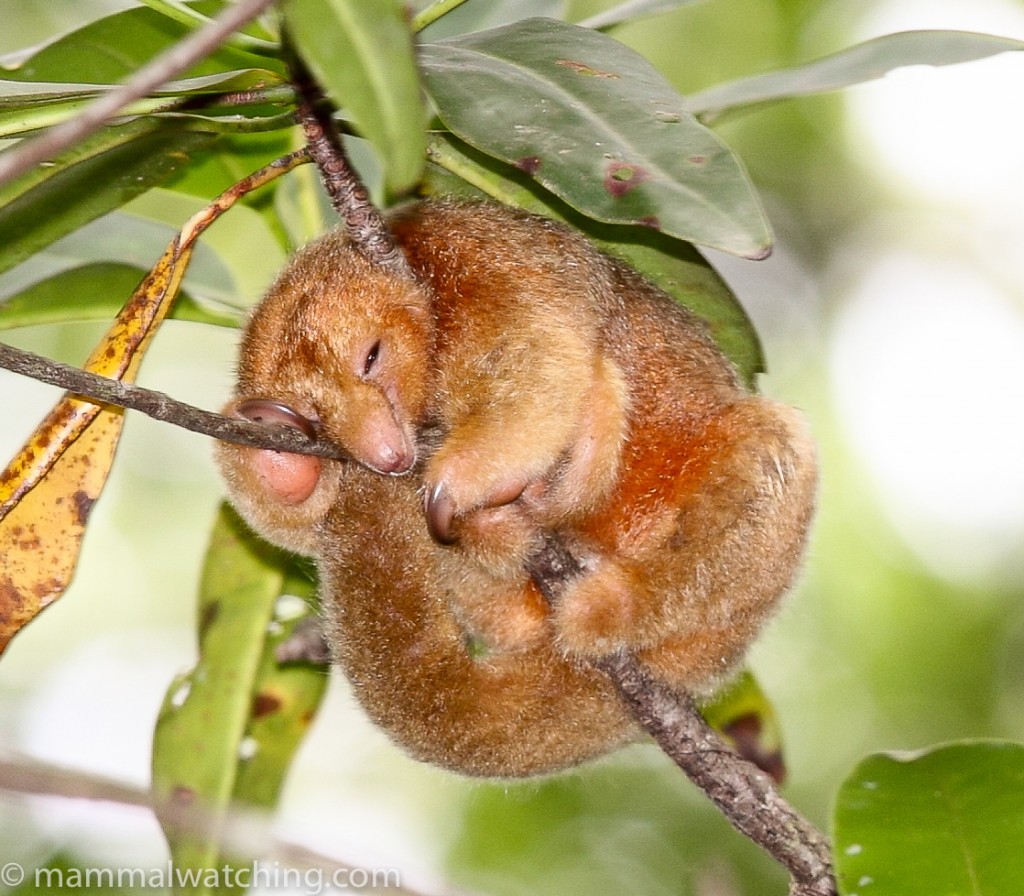
Silky Anteater, Cyclopes didactylus
We also lucked out with a sleeping Mexican Tamandua that one of the other boats spotted, curled up in the top of a hollow tree. Milenlly reckons she sees Tamanduas on about one trip in 5 so this was a bonus. Although its a widespread species in Costa Rica, it isn’t as easy to find as many of the mammals I was looking for.
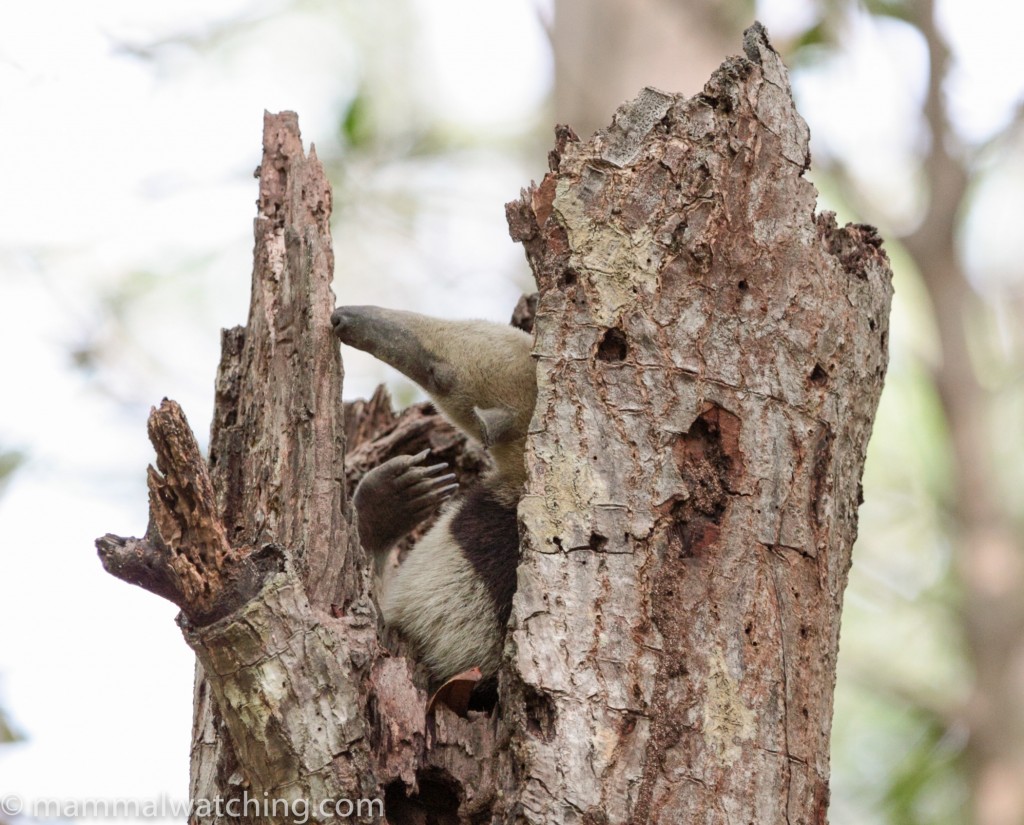
Mexican Tamandua, Tamandua mexicana
White-faced Capuchins (Cebus imitator) are common in the mangroves, and various tent making bat species are seen quite often under the palm leaves. We couldn’t find any, but did see these Lesser White-lined Bats.
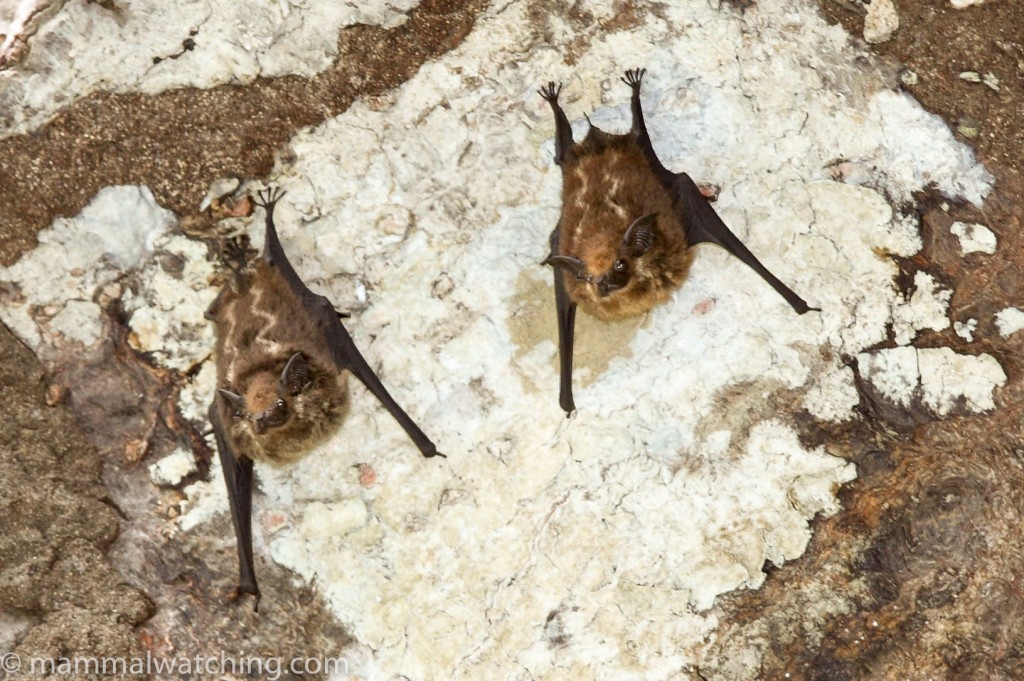
Lesser White-lined Bats, Saccopteryx leptura
When Milenlly saw how interested I was in the bats, she suggested her husband – Maurilio Cordero – took me to a bat cave at Damas near Quepos. The cave is on a farm in the middle of a palm plantation and it would be best to contact Maurelio to get access. Accessing the cave itself was easy and we spent 90 minutes inside photographing animals.
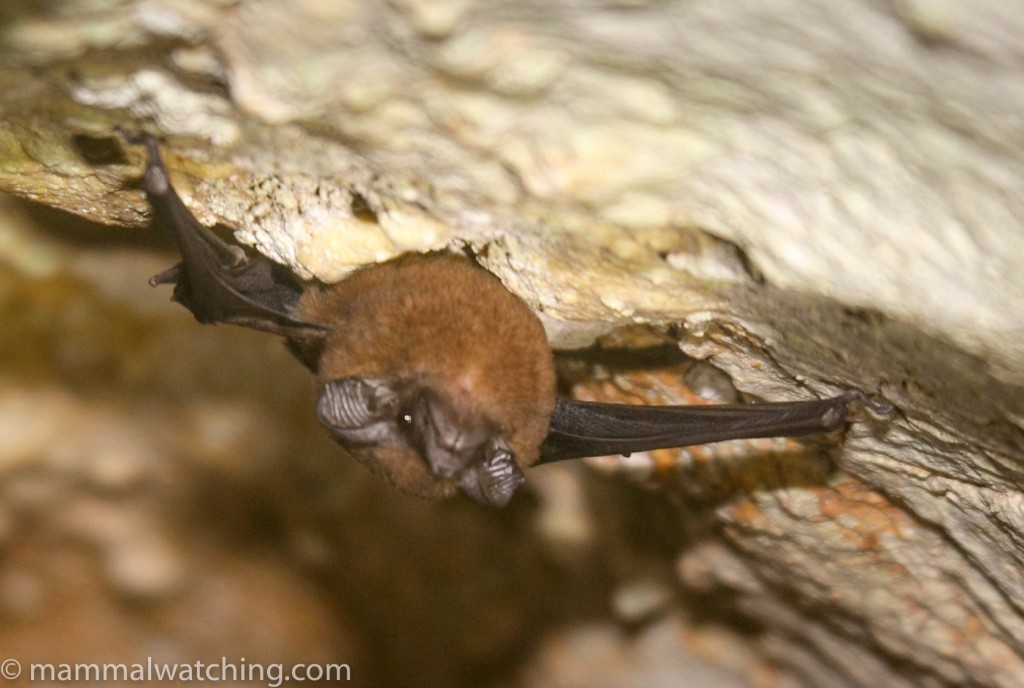
Lesser Dog Like Bat, Peropteryx macrotis
There were several species of bats, some of which I struggled identify, though as the cave has been surveyed I assume someone knows somewhere (and if that person is you please write to me!).
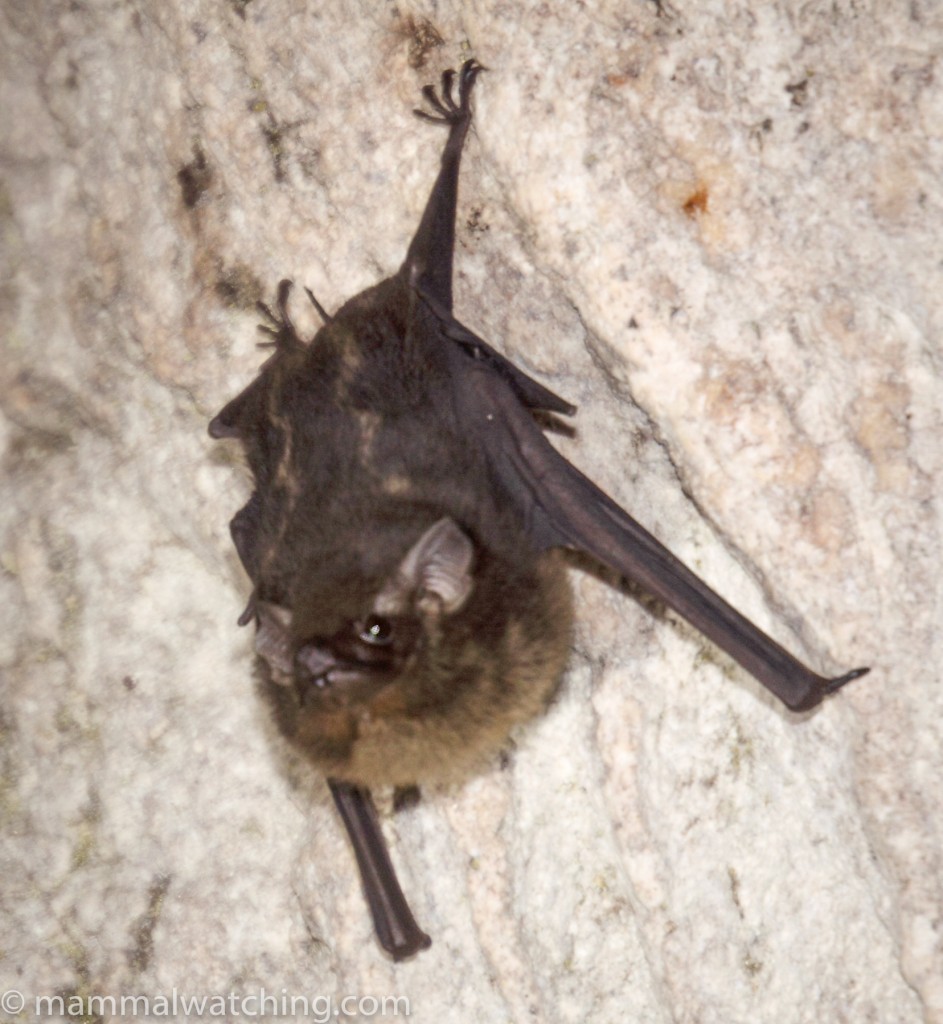
Greater White-lined Bat, Saccopteryx bilineata
At the entrance were some Greater White-lined Bats and some doglike bats, almost certainly Lesser Dog Like Bats (Peropteryx macrotis).
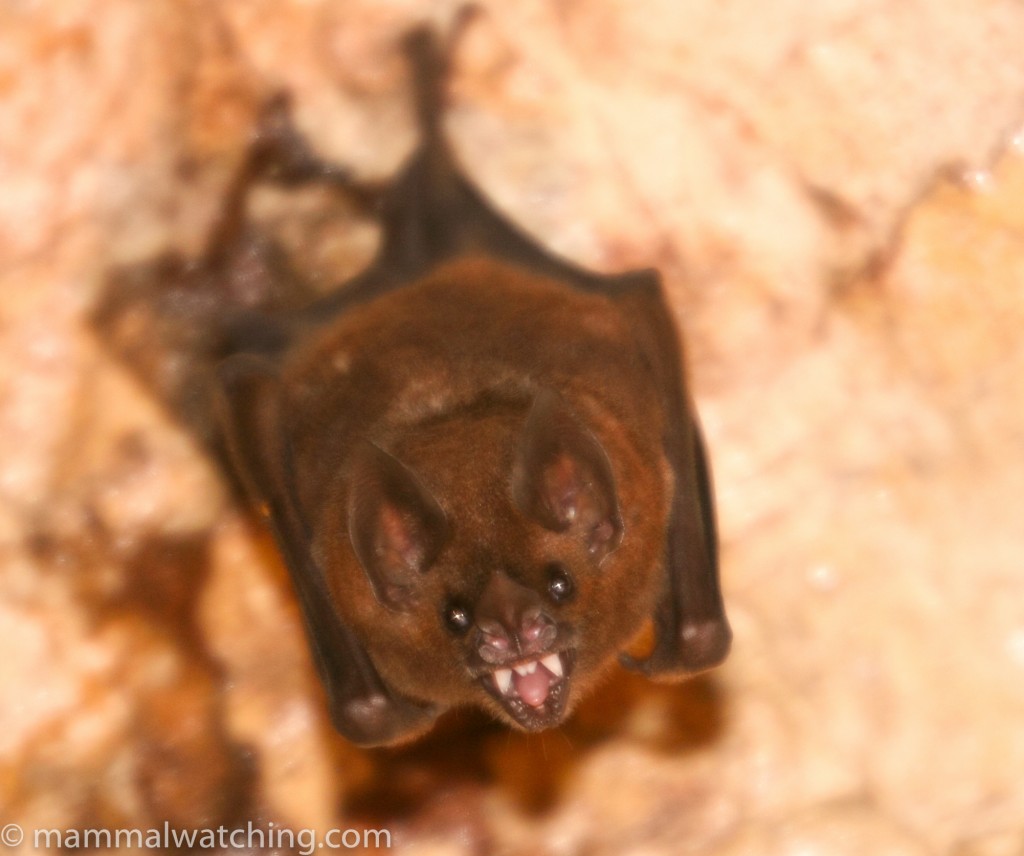
Seba’s Short-tailed Bat, Carollia perspicillata
One or more species of Carollia were abundant inside, and the reddish one above is apparently C. perspicillata.
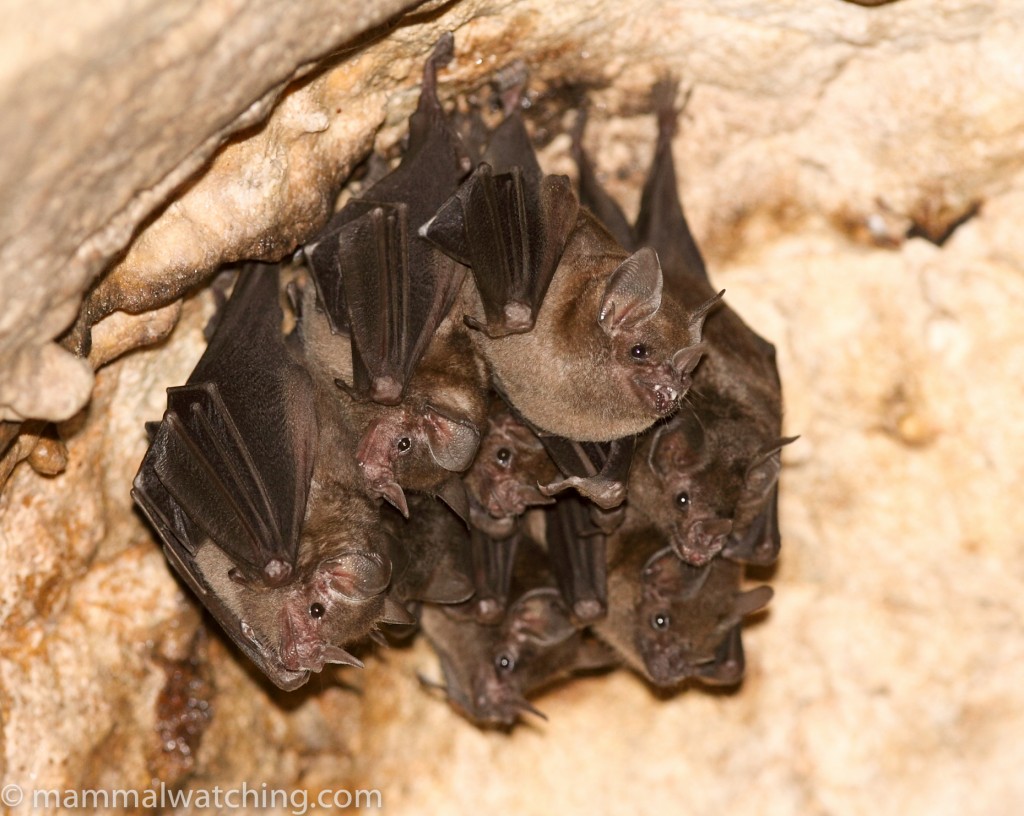
Carollia species
Several larger bats hanging from the roof were identified by Fiona Reid as Greater Spear Nosed Bats (Phyllostomus hastatus).
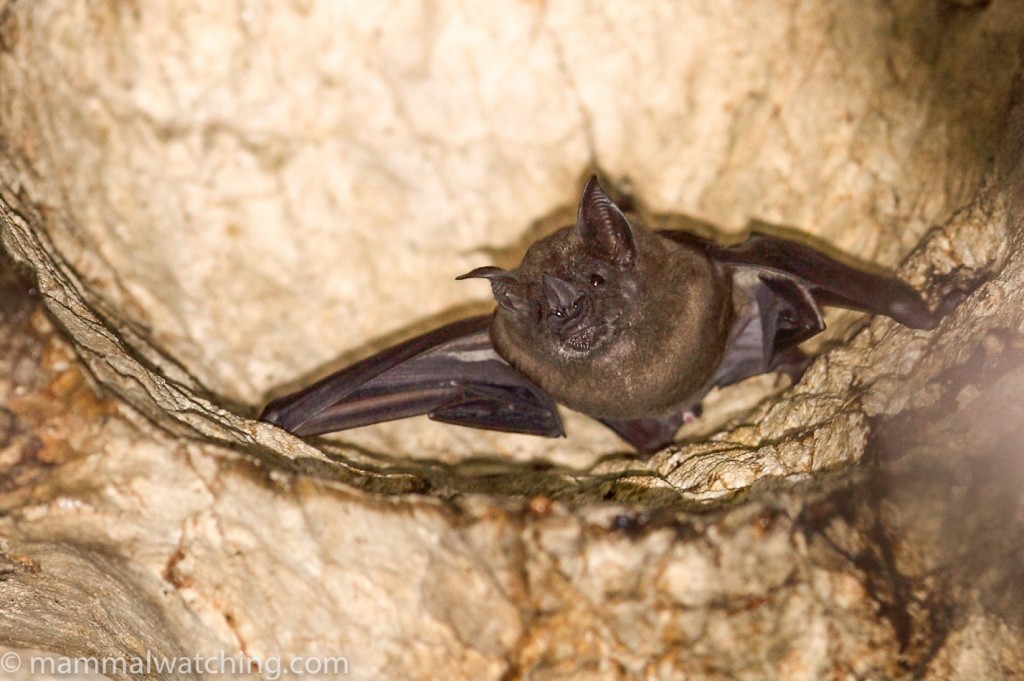
Greater Spear-nosed Bat, Phyllostomus hastatus
There were also a colony of 20 or so Common Vampire Bats.
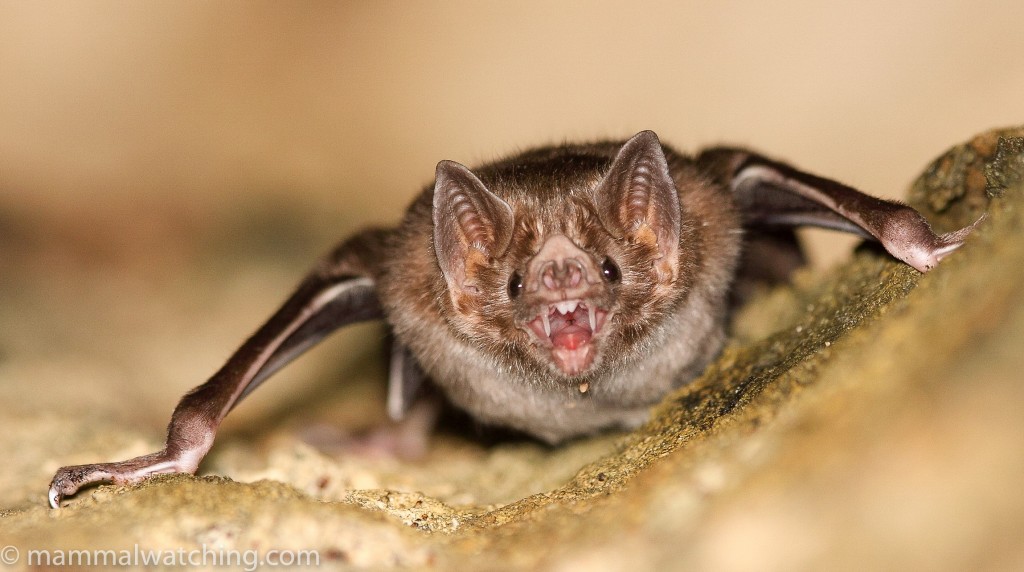
Common Vampire Bat, Desmodus rotundus
Finally a Mexican Greater Funnel Eared Bat was hanging on its own. This species has been split and the animal here was probably Natalus mexicanus, an unusual record according to Richard La Val.
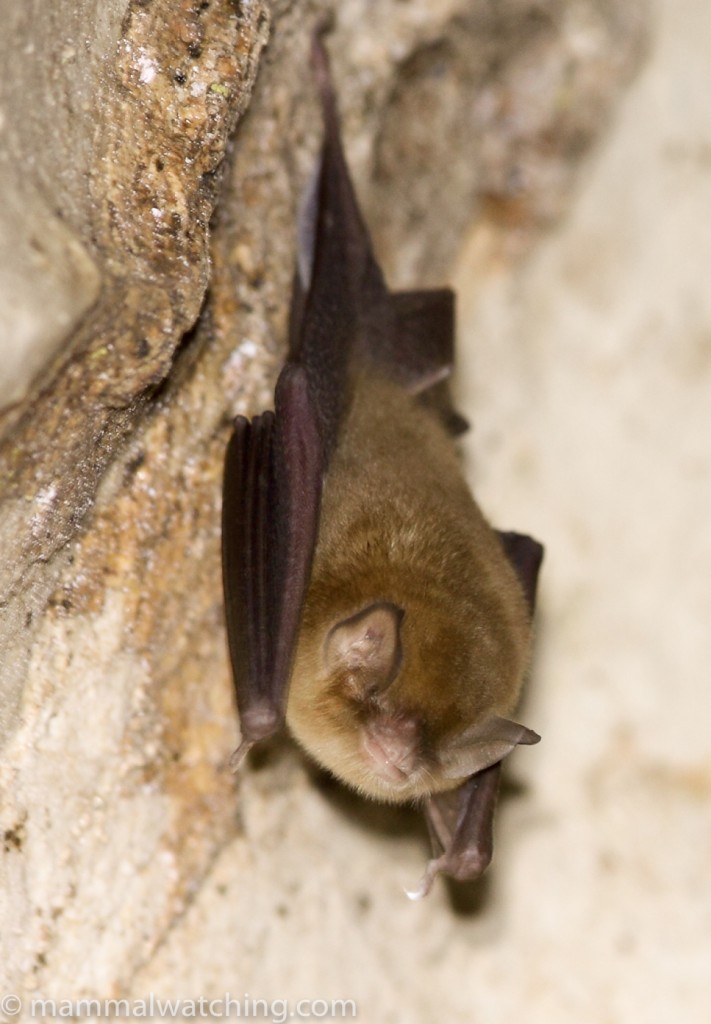
Mexican Greater Funnel Eared Bat, Natalus mexicanus
Maurelio often sees Squirrel Monkeys in the forest around the cave.
The national park is closed at night and I didn’t want to walk in there without permission, although it would have probably been alright, so instead I took a guided walk in the small Si Como No wildlife sanctuary a few kms north of the park. I didn’t see any mammals though we heard a Kinkajou. Striped Hog-nosed Skunks are seen from time to time, and smelled more often, and one of the mouse opossum species had recently been feeding inside the butterfly house and causing damage, though I did not see it.
Poas Volcano
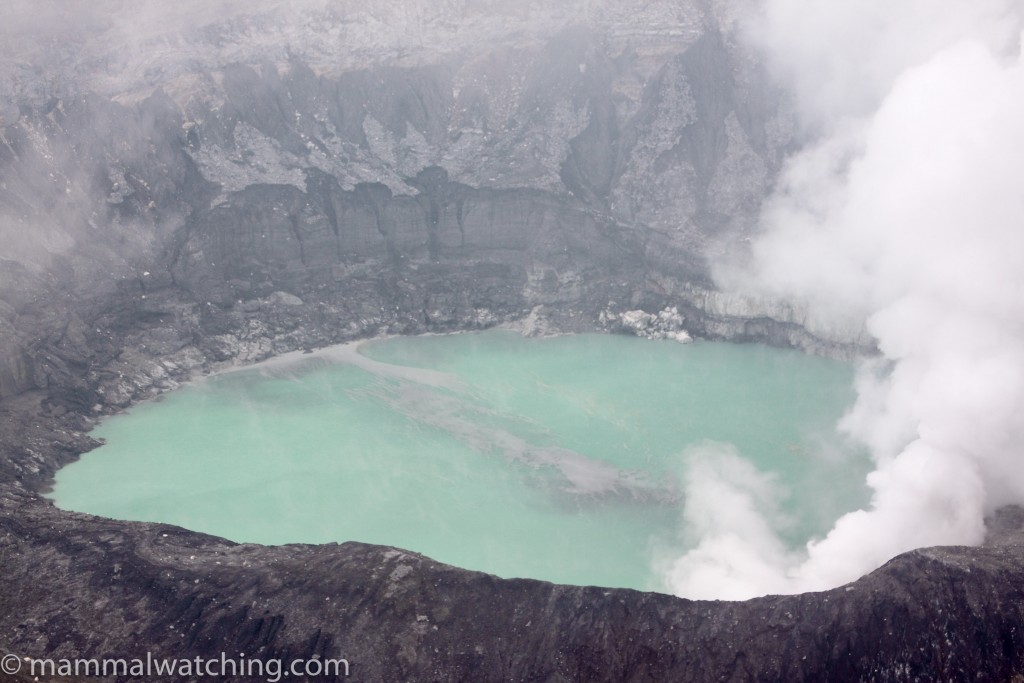
Poas Volcano National Park is 90 minutes north of San Jose. I visited twice. The first time I spent a night there and stayed at the lovely and incredibly friendly little Lagunillas Lodge. Apart from seeing the volcano crater, I hoped to see the Montane or Poas Squirrels here, which are apparently the dominant squirrel in the park. I couldn’t find any near the lodge, though they ought to be around, and the next day the weather was abysmal. I returned for a couple of hours on my way back to San Jose and did see the crater for a minute or two when the clouds parted, as well as several very tame Red-tailed Squirrels around the Lagunas viewing area, but not the much smaller Montane Squirrels. Early morning on a decent day ought to bring sightings though: several people I spoke to were sure that the smaller squirrels were common.
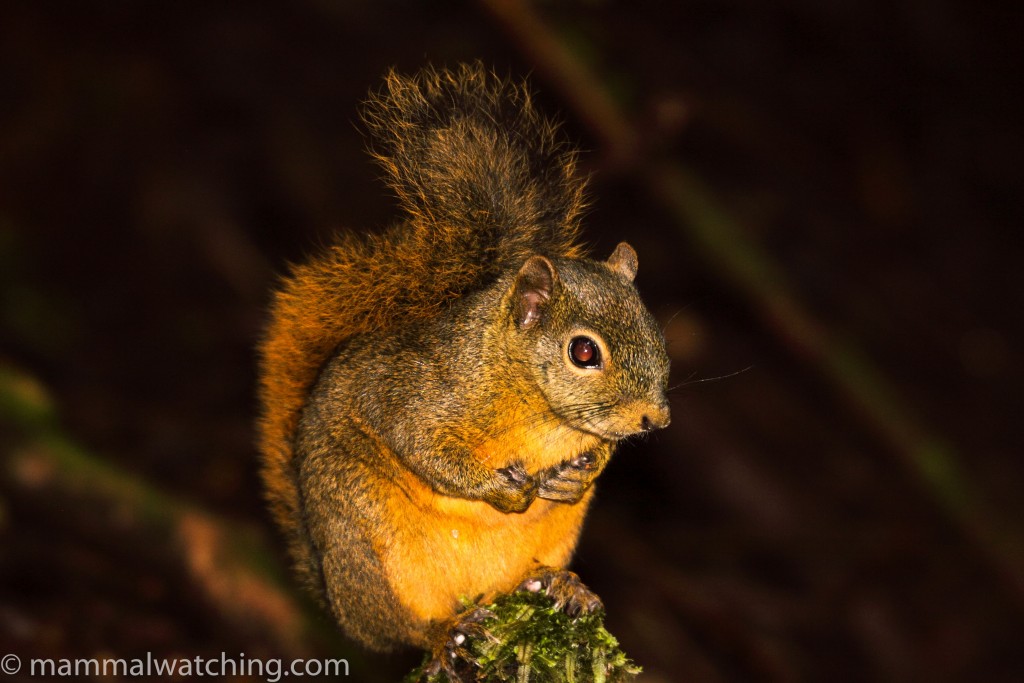
Red-tailed Squirrel, Sciurus granatensis
Spotlighting along the drive of the lagunillas lodge and to the entrance of the national park did throw up a couple of rabbits: most likely Tapitis. No one seems to know which species are at Poas as Dice’s Cottontail might be a possibility there . The owners of the lodge said Raccoons and Coyotes were common.
I set 10 Elliott traps around the lodge but caught nothing, much to the owners’ surprise.
Tirimbina Lodge
Tirimbina Lodge, near Puerto Viejo de Saripiqui, is a mammal watcher’s wet dream, especially if you have a thing for bats. It is a sort of field studies centre for students and researchers, set in lowland rainforest and Bernal Rodriguez-H, a top bat expert, works there. As a result there is a strong bat focus, with mist-netting every night, and an opportunity to take a “bat walk” during the day.
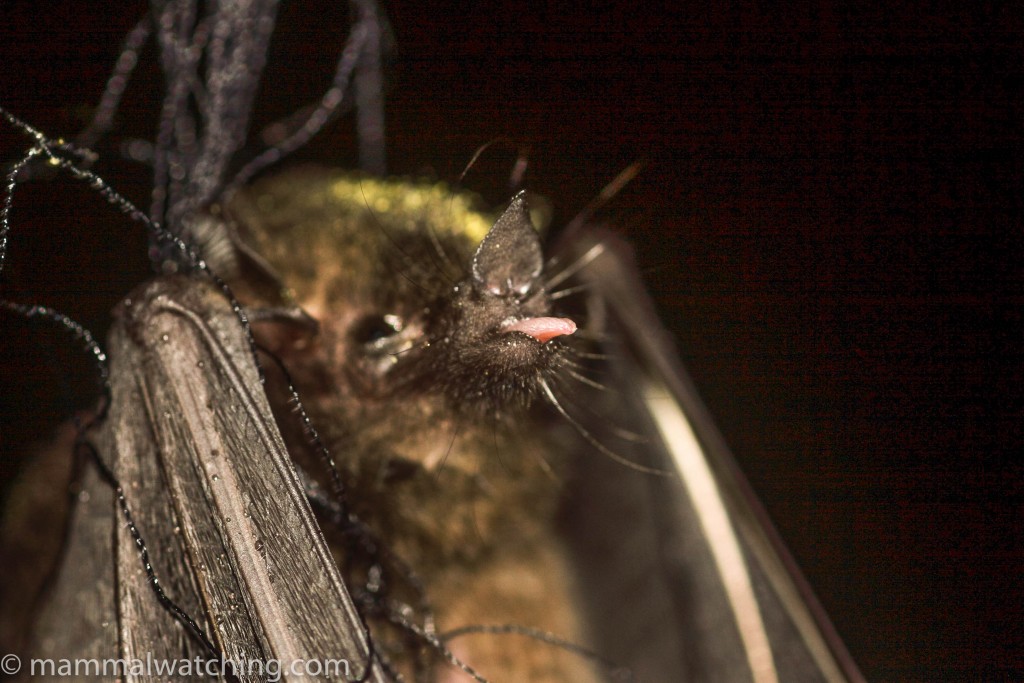
Glossophoga species in the net
They also run night tours and other stuff. The lodge is close to La Selva, a government biological station where visitors can also stay, which is also supposed to be very good for mammals.
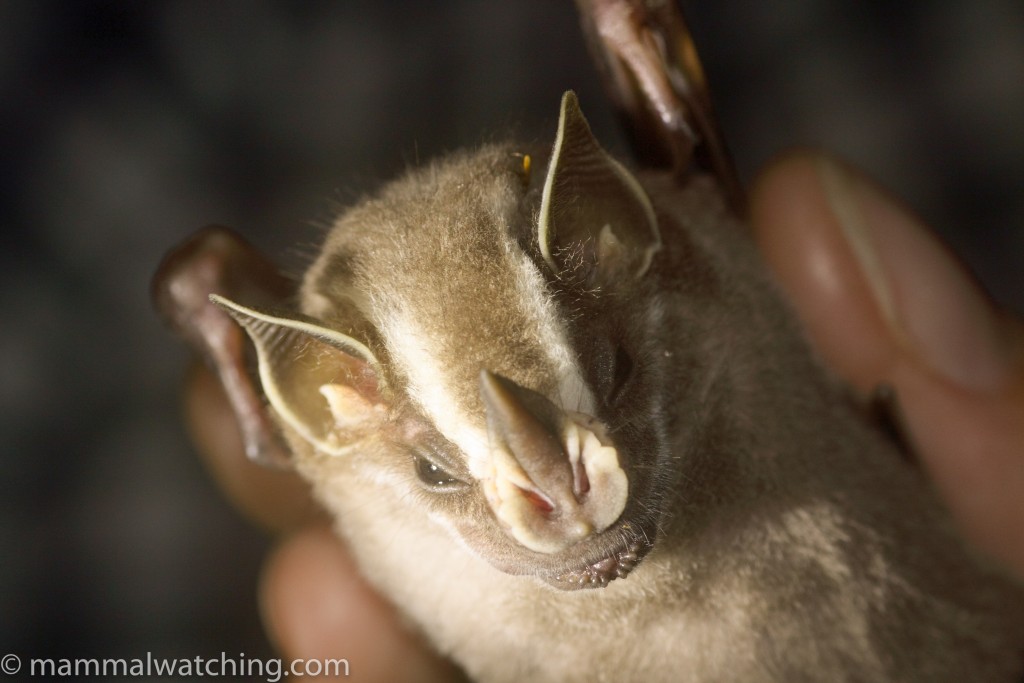
Tent-making Bat, Uroderma bilobatum
It should have taken me an hour to drive to Tirimbina from Poas Volcano. But half way along the road to La Virgen a sign said there was a severe risk of landslides and nothing but heavy machinery was allowed past, I assume this was a result of the big earthquake a couple of years earlier. I ignored the sign, noting that the heavy machinery didn’t seem to concerned about me driving on by. But there was also torrential rain, and the road was more like a river. And so if there was going to be a landslide, it was going to be now and, for once, I chickened out, turned around and took a three hour detour.
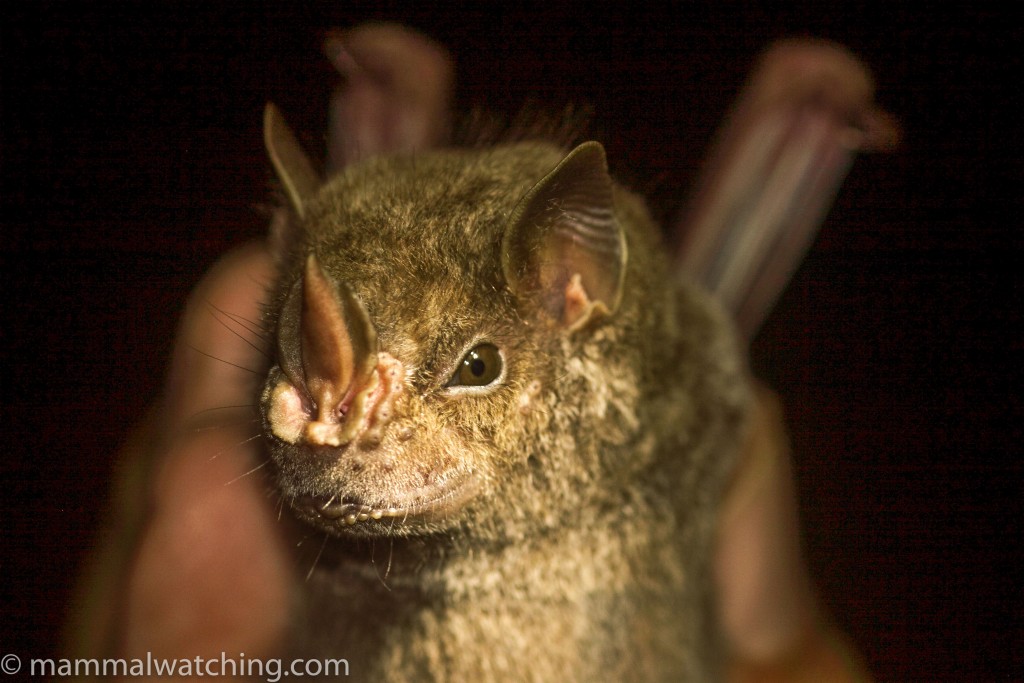
Hairy Big-eyed Bat, Chiroderma villosum
I joined the students netting bats that evening and we caught five species in a couple of hours, including Tent-making Bats, a Hairy Big-eyed Bat and this Sowell’s Short-tailed Bat, a recent split from the Silky Short-tailed Bat, Carollia brevicauda.
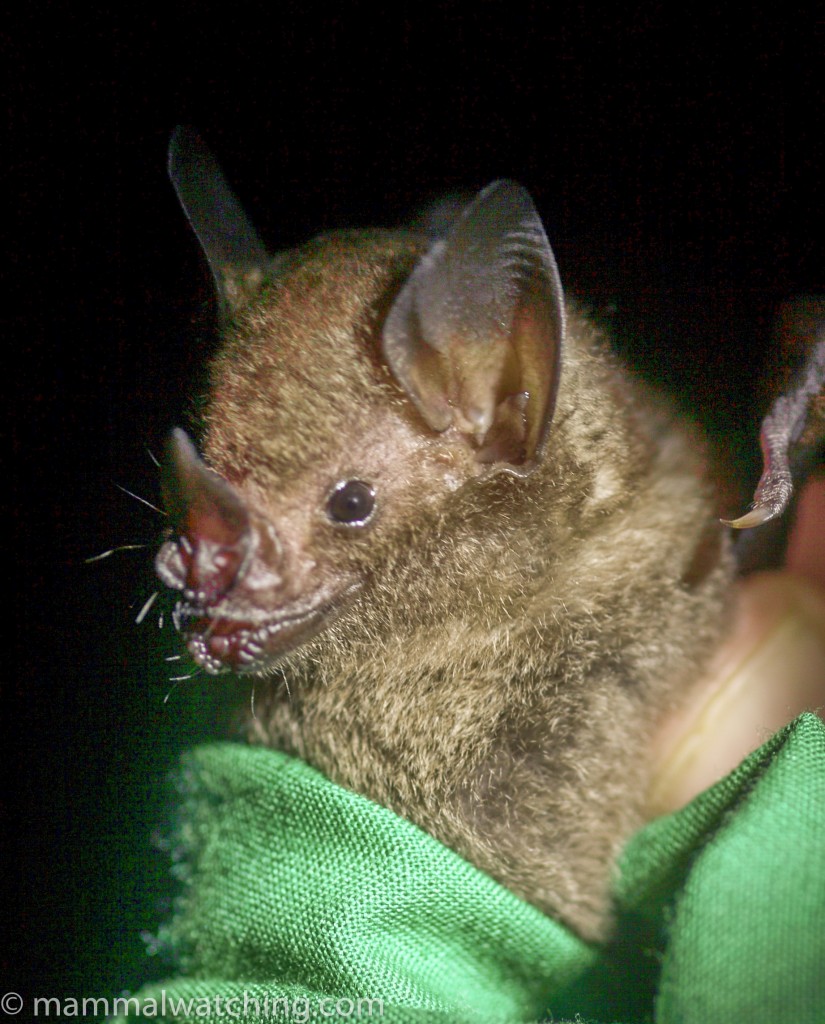
Sowell’s Short-tailed Bat, Carollia sowelli
We also caught some pretty little Macconnell’s Fruit Bats, and a long-tongued bat which was not identified to species level.
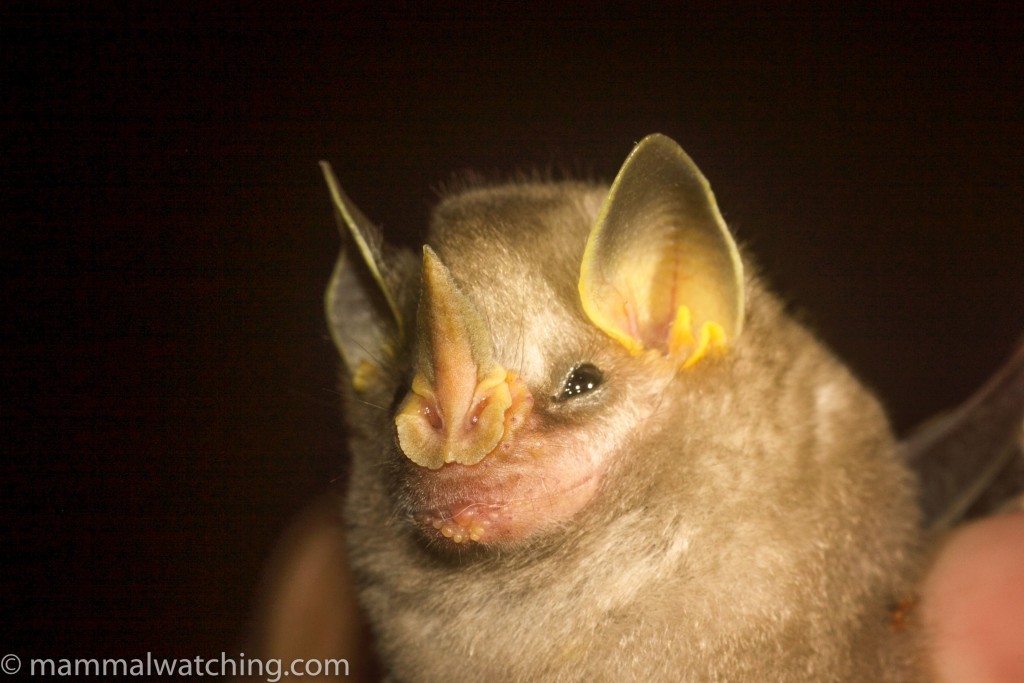
Macconnell’s Fruit Bat, Mesophylla macconnelli
The next morning Eugenia, Manuel and Gato (aka Christian) took me on a three hour walk through the rainforest looking for roosting bats. The three of them knew a number of roosts, and were excellent at finding tents of bats.
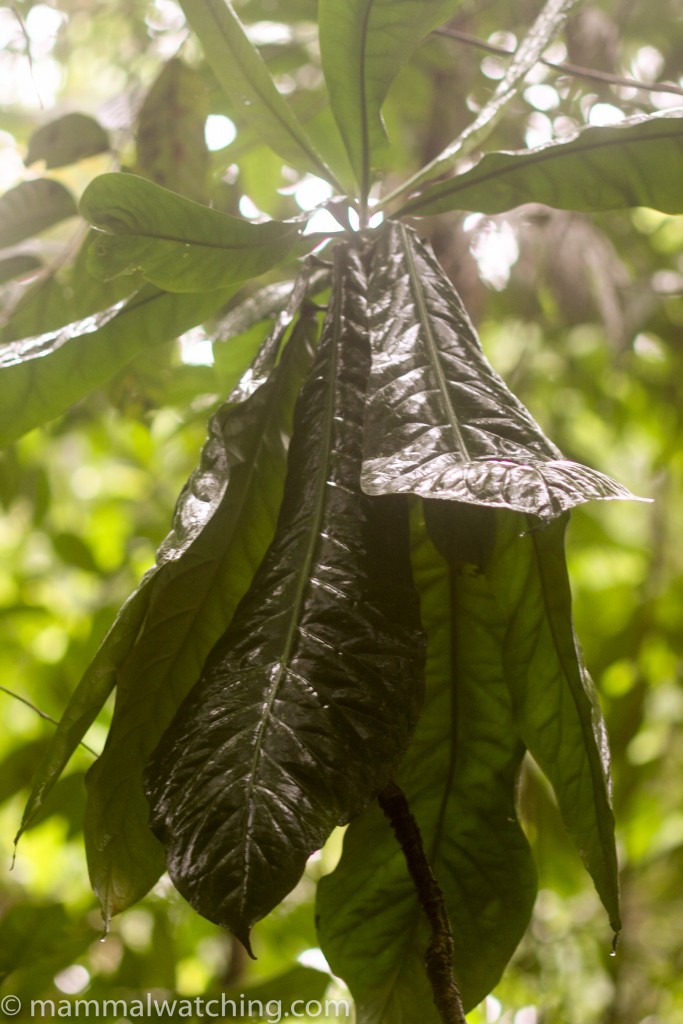
Bat tent
Many of the Costa Rican bats fashion tents for themselves out of leaves: they chew ‘dotted lines’ in the leaves then fold along them by pulling the leaves into a structure rather like two walls with a roof… quite distinctive when you know what to look for. Another tent looked more like a wigwam. Other bats roost inside rolled Heliconia leaves, but though we found some rolled up leaves there was no one home.
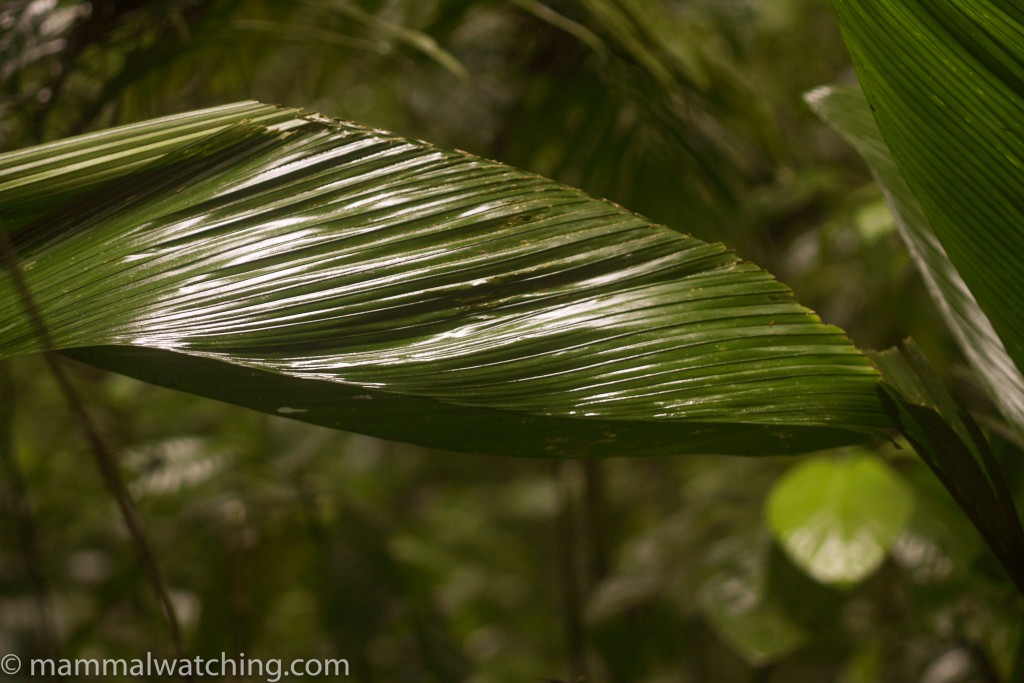
Bat tent
We had an excellent morning, finding another seven species, six of them new for me. Some Allen’s Short-tailed Bats (Carollia castanea) were roosting under the exposed roots of a tree, as were a colony of Hairy Large-eared Bats (Micronycteris hirsuta) which flew before I could photograph them. They were followed by some very flighty Big Yellow-eared Bats (Vampyriscus nymphaea): they had to be approached very carefully because they fly at the slightest disturbance. Some Thomas’s Fruit-eating Bats (Dermanura watsoni), also in a tent, were easier to approach.
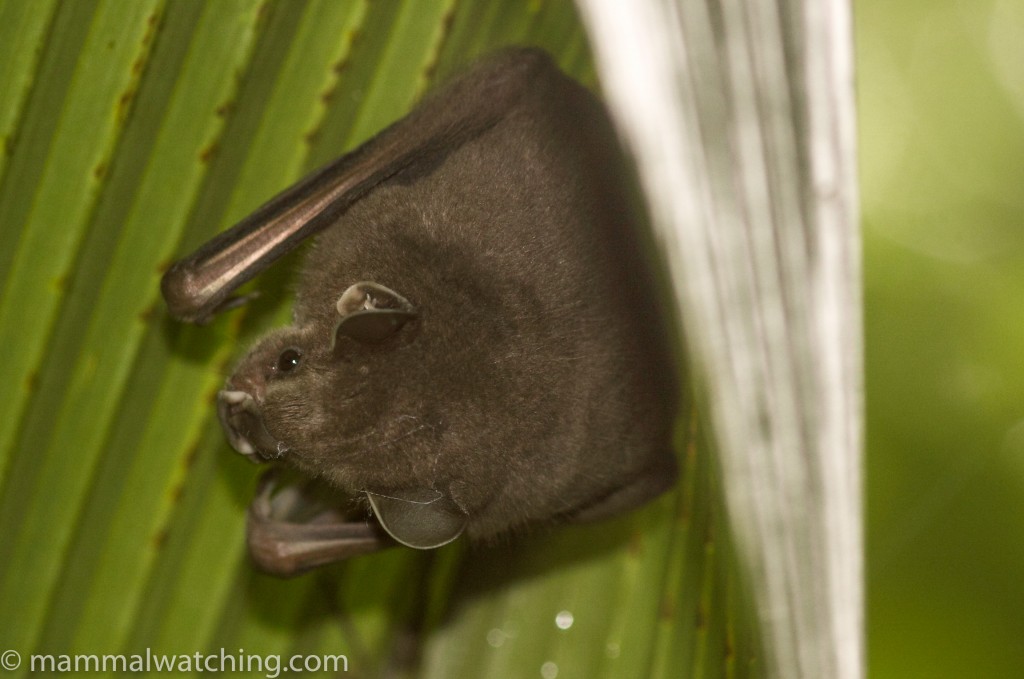
Thomas’s Fruit-eating Bat, Dermanura watsoni
Next were some Lesser White-lined Bats on a tree, followed by Wagner’s Sac-winged Bats (Cormura brevirostris) under a fallen tree with perhaps another species too down there.
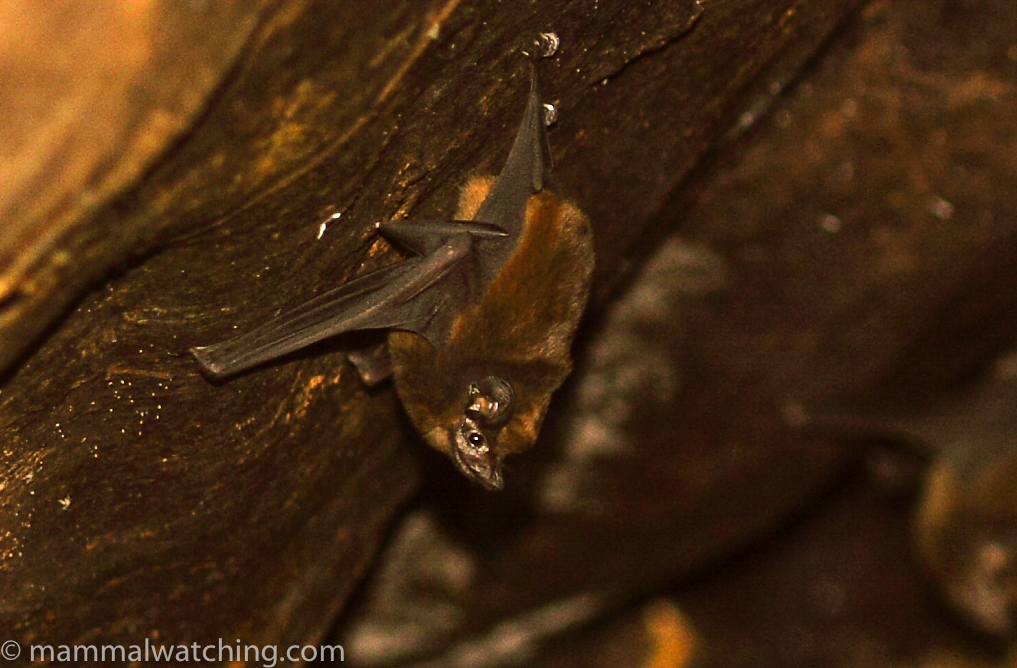
Wagner’s Sac-winged Bats, Cormura brevirostris
I was within inches of treading on a Fer de Lance while looking at these guysLsuch good camouflage!
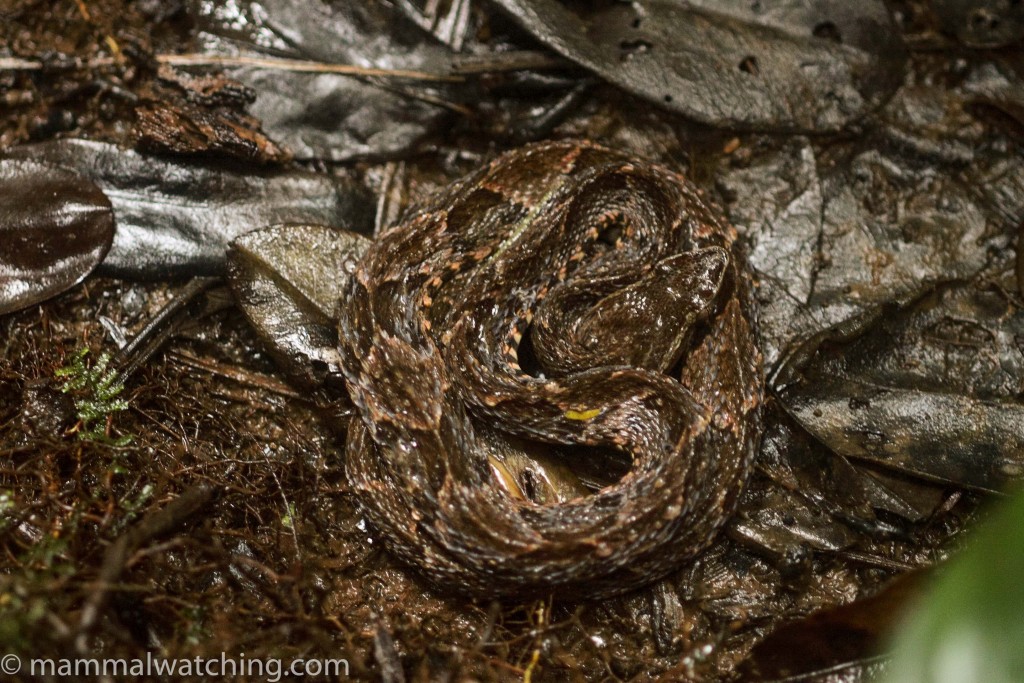
Fer de Lance
FInally, Manuel spotted a Thomas’s Bat (Centronycteris centralis) hanging on a leaf quite high up.
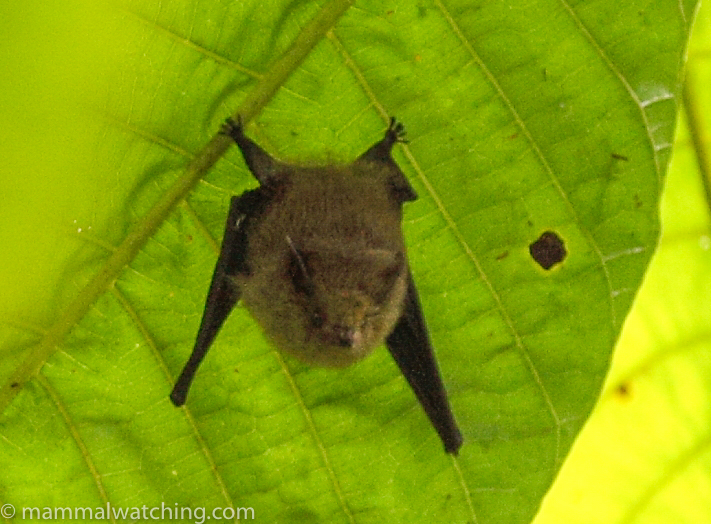
Thomas’s Bat, Centronycteris centralis
So a great morning’s batting, but we still hadn’t seen the major target of the day, the Honduran White Bats (Ectophylla alba). But they were around and after lunch we went to another bit of the park and found a camp within 20 minutes. Beautiful things.
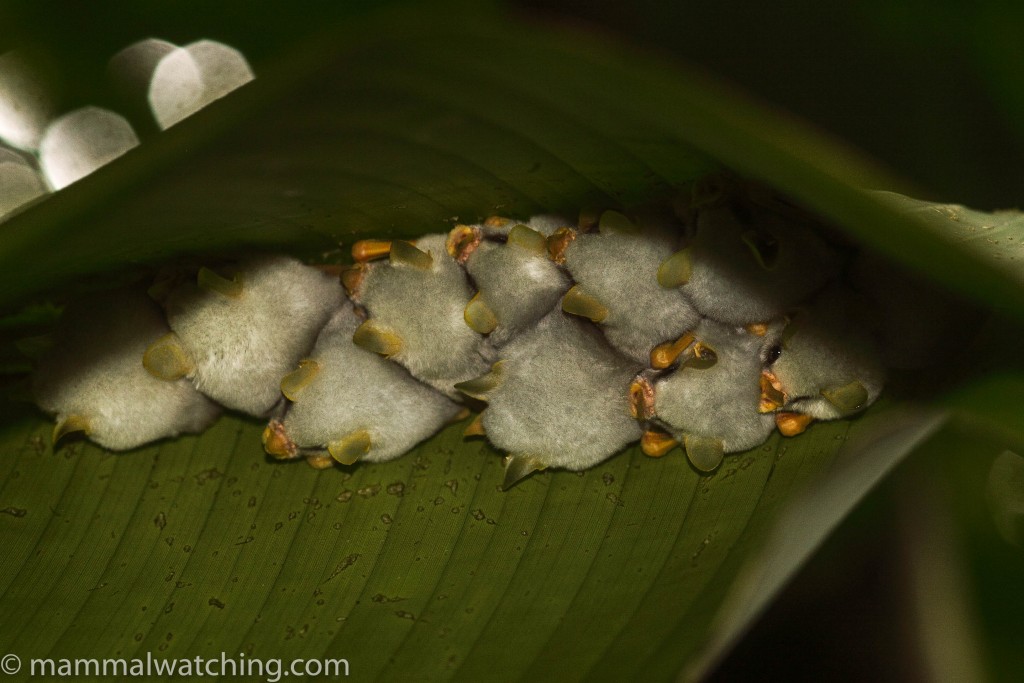
Honduran White Bats, Ectophylla alba
I also saw my first Variegated Squirrel in a tree near the entrance to the lodge at lunchtime.
A long canopy bridge crosses the river near the lodge. It is a great spot for spotlighting apparently (I didn’t have time) with several animals using it to cross the river. I was told a Mexican Porcupine is usually shuffling along it just after dark, and Kinkajous are frequent visitors. A Woolly Opossum had been denning in one of the metal support rods until recently.
So Tirimbina is a great place! At least 15 species in 24 hours, 14 of them lifers for me, great guides, nice accommodation and bargain prices too. One of the best mammal watching places I have ever been. If only there were more lodges like Tirimbina.
Monteverde
Monteverde, about three hours north of San Jose, is a decent patch of cloud forest that sees many tourists. A lot of people run night walks and other wildlife activities there, so its quite easy to see several nice mammals here.
I spent several evenings here. This was longer than I had planned because the bloody Olingos I wanted to see would not be found. But more about this later.
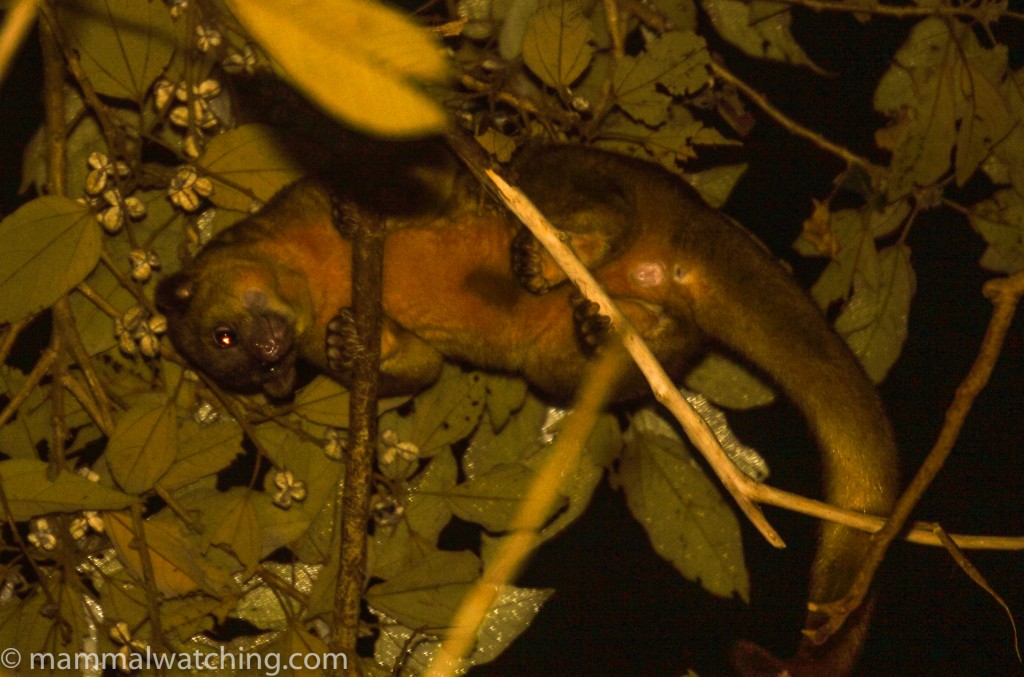
Kinkajou, Potos flavus
I arrived late on my first night, but found a couple of Kinkajous at midnight near the creek at the Cloud Forest Lodge. And there was a Variegated Squirrel at dawn on the same trail.
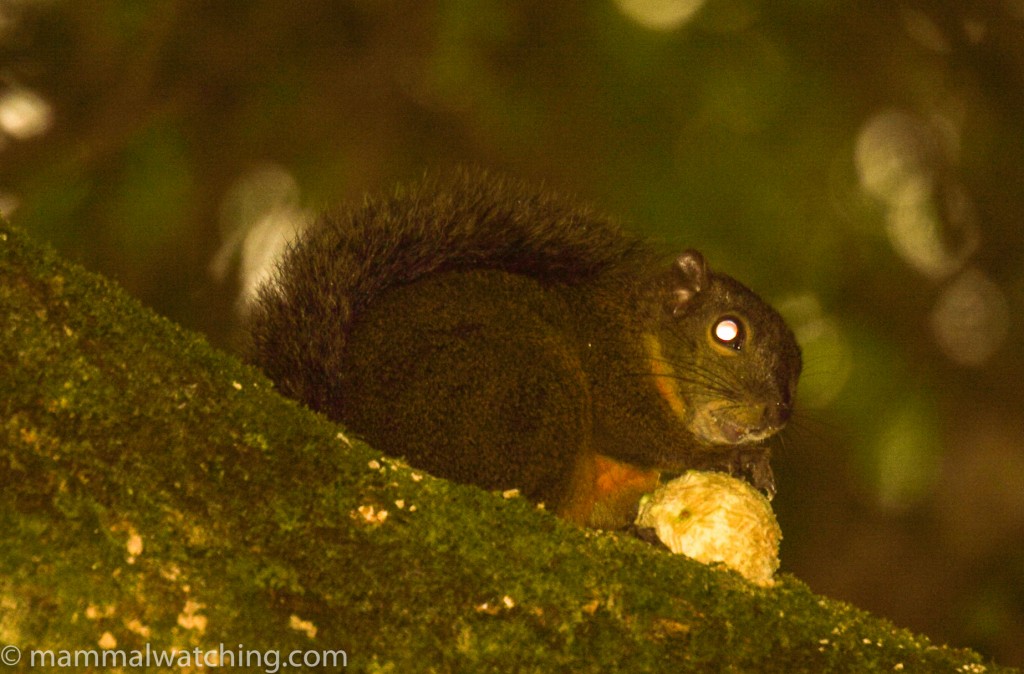
Variegated Squirrel, Sciurus variegatoides
I didn’t see much during the day but did visit the Bat Jungle in Monteverde Village, run by Richard La Val. It is a nice exhibition centre, with a fun colony of captive bats, flying around a large enclosure. Well worth a visit.
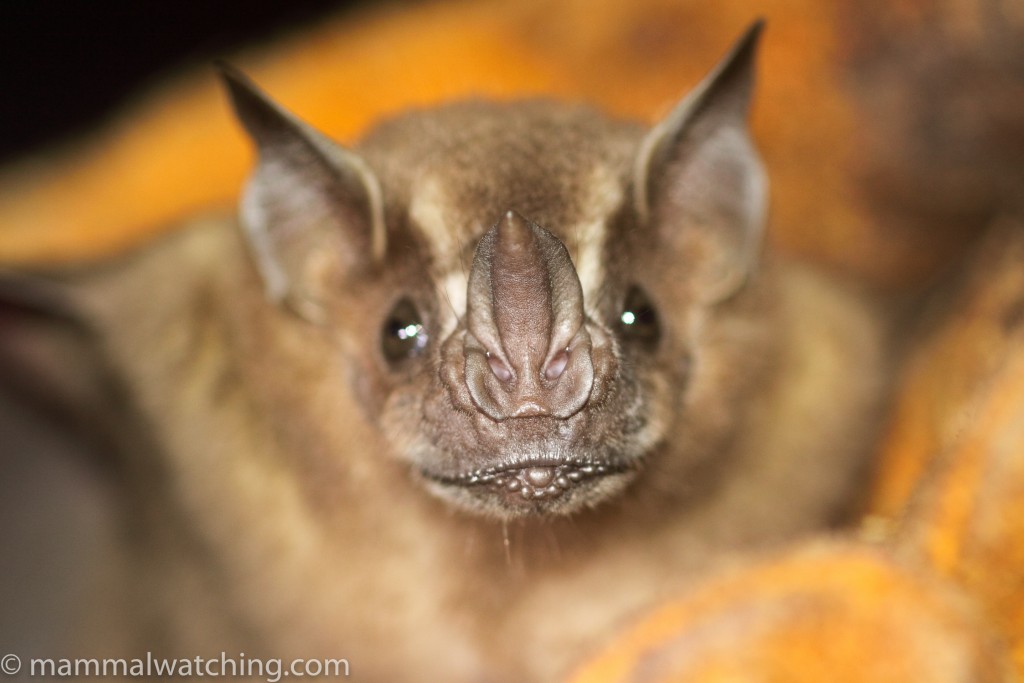
Intermediate Fruit-eating Bat, Artibeus intermedius
Richard was doing some trapping that evening with a group of college students from the US and he was happy for me to come along too as another “expert”. We were netting in some secondary forest out near the Reserva Santa Elena. It was a full moon, and windy too, but in a couple of hours we caught a Riparian Myotis and five different species of Artibeus.
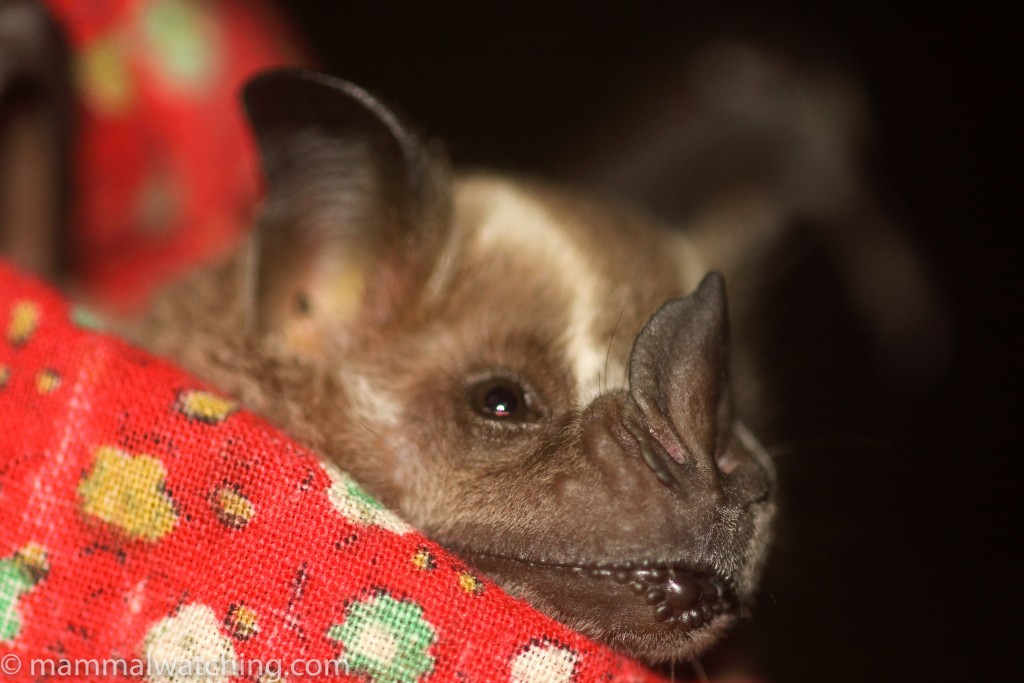
Big Fruit-eating Bat, Artibeus lituratus
We caught Jamaican Fruit-eating Bat (Artibeus jamaicensis), Thomas’s Fruit-eating Bat (Dermanura watsoni), Intermediate (San Jose) Fruit-eating Bat (in 2023 split from Artibeus lituratus into Artibeus intermedius), Big Fruit-eating Bat (Artibeus lituratus), and a Toltec Fruit-eating Bat (Dermanura toltecus).
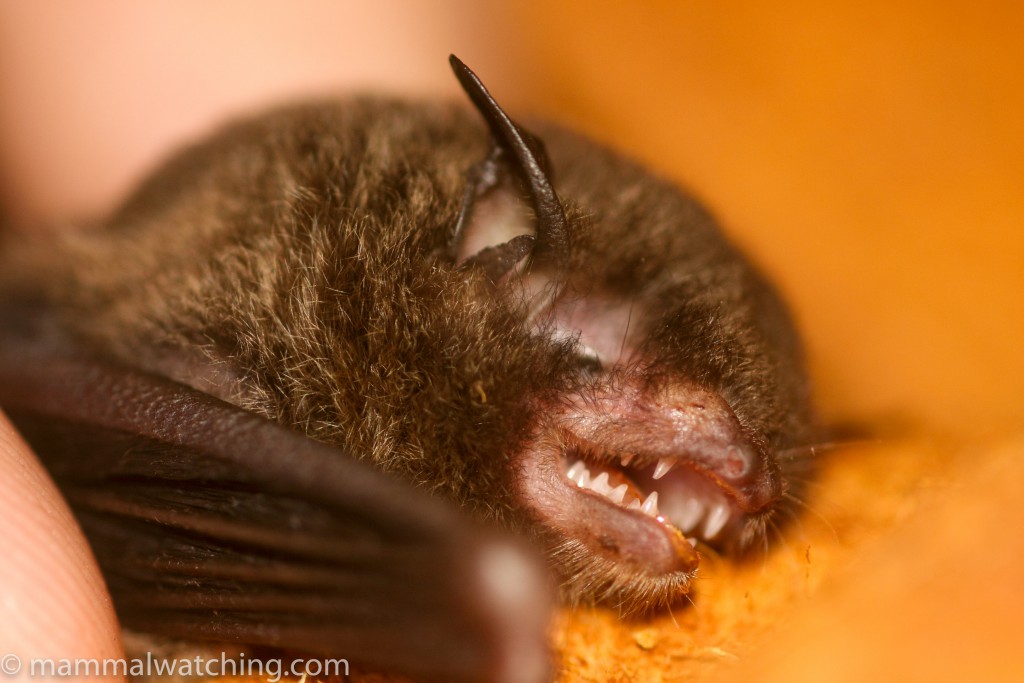
Riparian Myotis, Myotis riparius
Mexican Porcupines and Three-toed Sloths are seen frequently sleeping in trees in the Monteverde National Park (ask the guides if they have seen any) and Tayras are seen occasionally. Alfaro’s Pygmy Squirrels are apparently common, despite what some people told me to the contrary, but I didn’t see any.
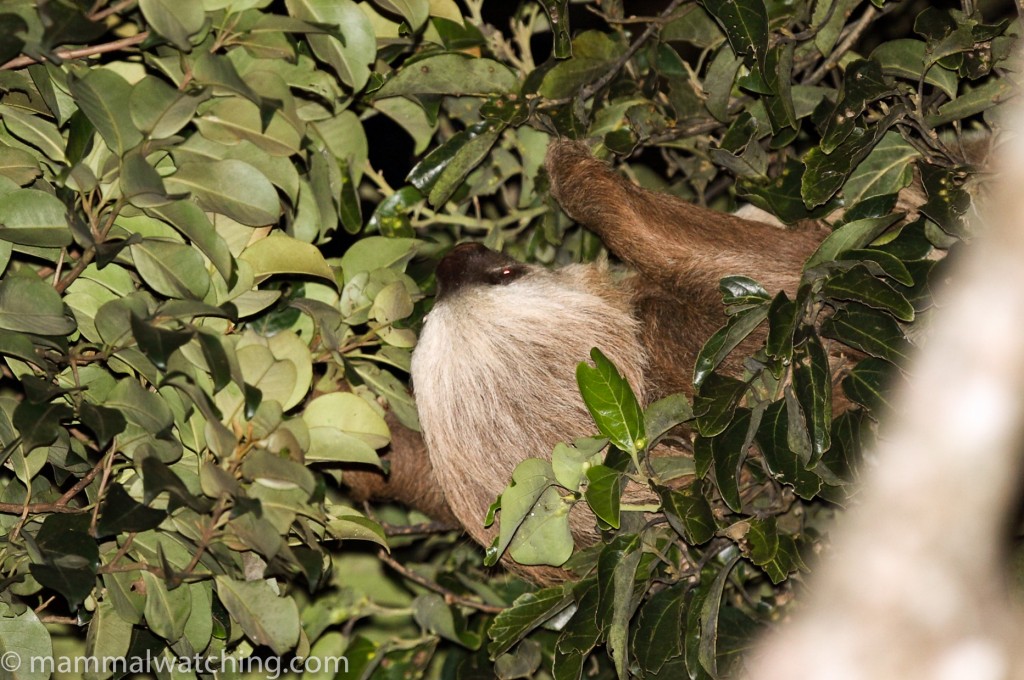
Hoffmann’s Two-toed Sloth, Choloepus hoffmanni
My target animals here were Mexican Porcupines and Olingos. The former should be easy to find. If you don’t see one in the national park then phone a few of the private nature reserves and ask. The Sendero Valle Escondido (Hidden Valley Trail) seemed quite good for instance. They told me they had seen an Olingo during every night walk recently because they were leaving some ripe bananas out for them near the office. And they always saw a Mexican Porcupine that denned in a big hollow fig tree about 100 metres down the trail (at the first t-junction). I couldn’t see the Porcupine at midday but at 5 p.m. it was lower down the tree. A nice animal. I also saw a Red-tailed Squirrel.
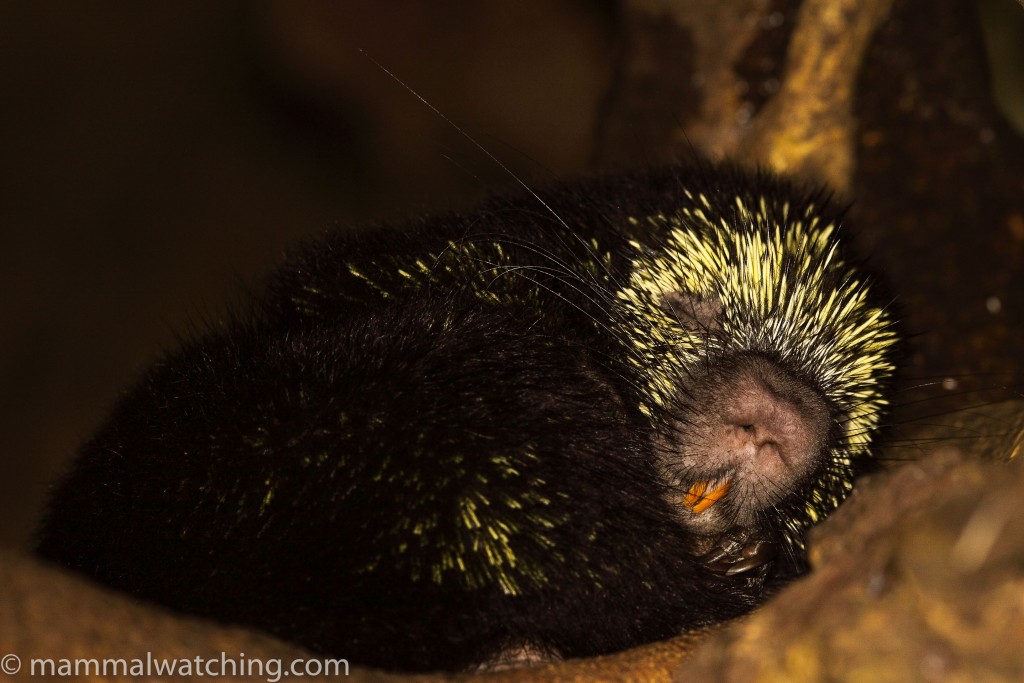
Mexican Hairy Dwarf Porcupine, Coendou mexicanus
But the Olingo did not show that night, nor had it shown the night before, nor the night after. I suspect the full moon didn’t help.
Another reliable spot for Olingos is at the feeders outside the hummingbird gallery next to the park entrance. They are often seen here in the day time, and nearly always at night. The guys in the gallery said they had only seen it a couple of times in January and February 2010 in the daytime, and that was when the weather was bad. But most of the park night walks saw it at about 7 p.m. I visited over three evenings.
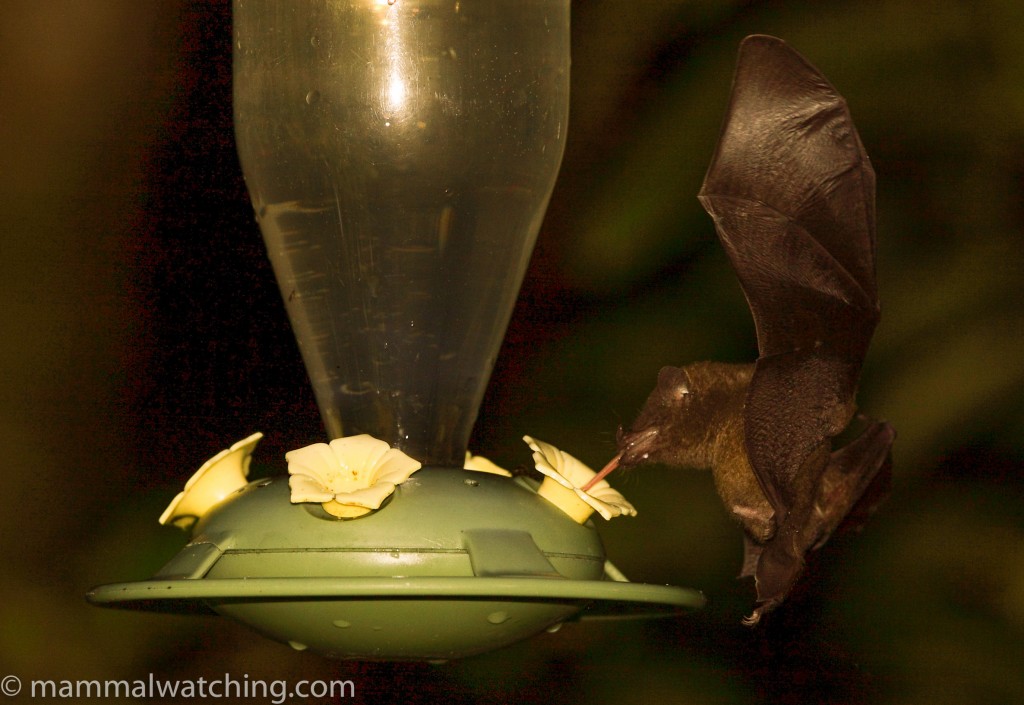
Long-nosed bat species feeding
I arrived at around 9 p.m.during the first two evenings, and by this point the hummingbird feeders had been emptied, presumably by long-nosed bats and perhaps an Olingo. One bat was obliging enough to hang from a hummingbird feeder hook and is apparently an Underwood’s Long-tongued Bat (Hylonycteris underwoodi). On the last evening I sat outside from 17.30 to 19.30. No Olingo. Lots of bats… but no Olingo. This was the biggest disappointment of the trip.
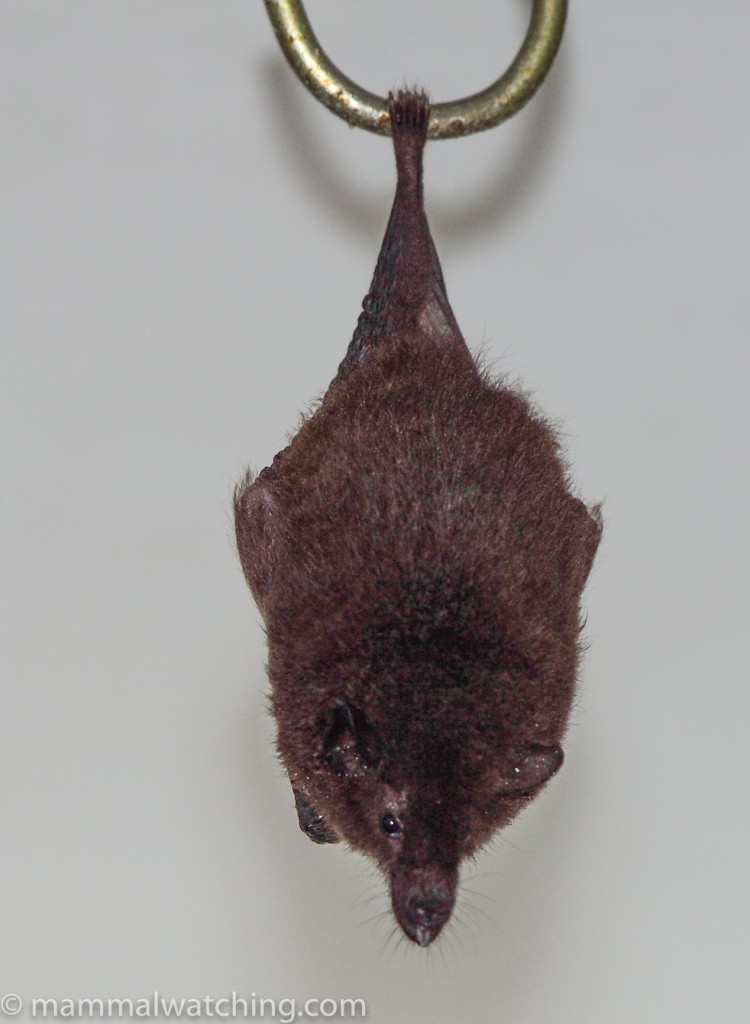
Underwood’s Long-nosed Bat, Hylonycteris underwoodi
Richard La Val told me that they have 26 hummingbird feeders at the Selvanatura centre that they leave out at night. The place is apparently swarming with bats though I didn’t visit. It could be another spot for Olingos I guess.
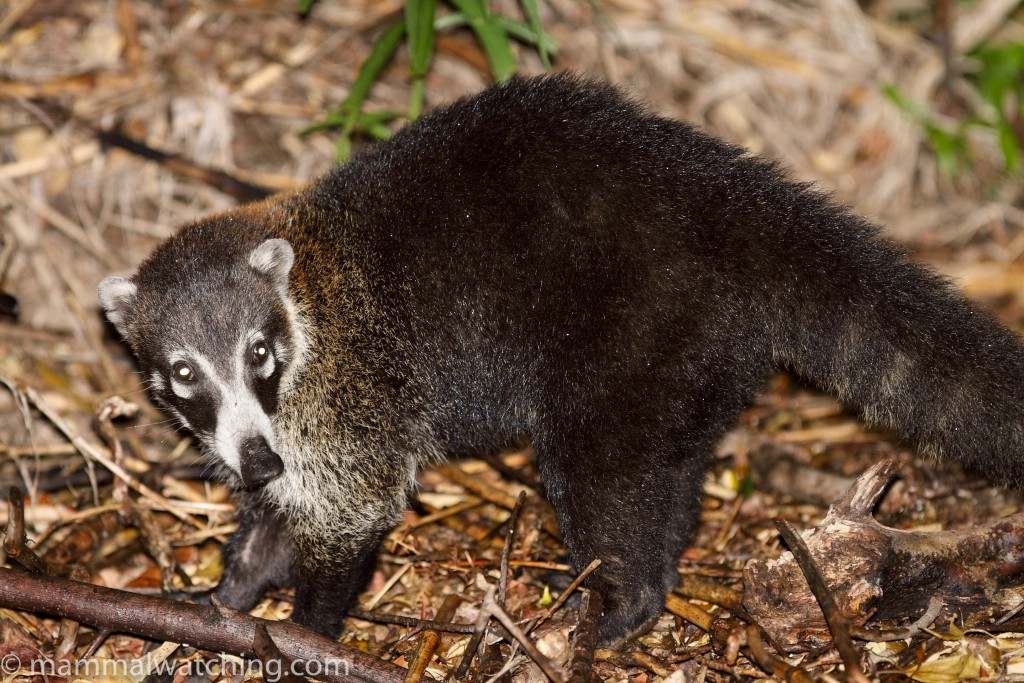
White-nosed Coati, Nasua narica
Despite the lack of an Olingo, and the abundance of noisy Brits and Americans, the Hidden Valley night walk was pretty good. A mob of White-nosed Coatis and a couple of Central American Agoutis were running around at dusk. We also saw the porcupine again, plus a couple of Two-toed Sloths (which are quite rare in Monteverde it seems), one of which came down to the ground for its weekly toilet stop. They can actually climb fairly quickly. A pair of Pumas had been here two weeks before me.
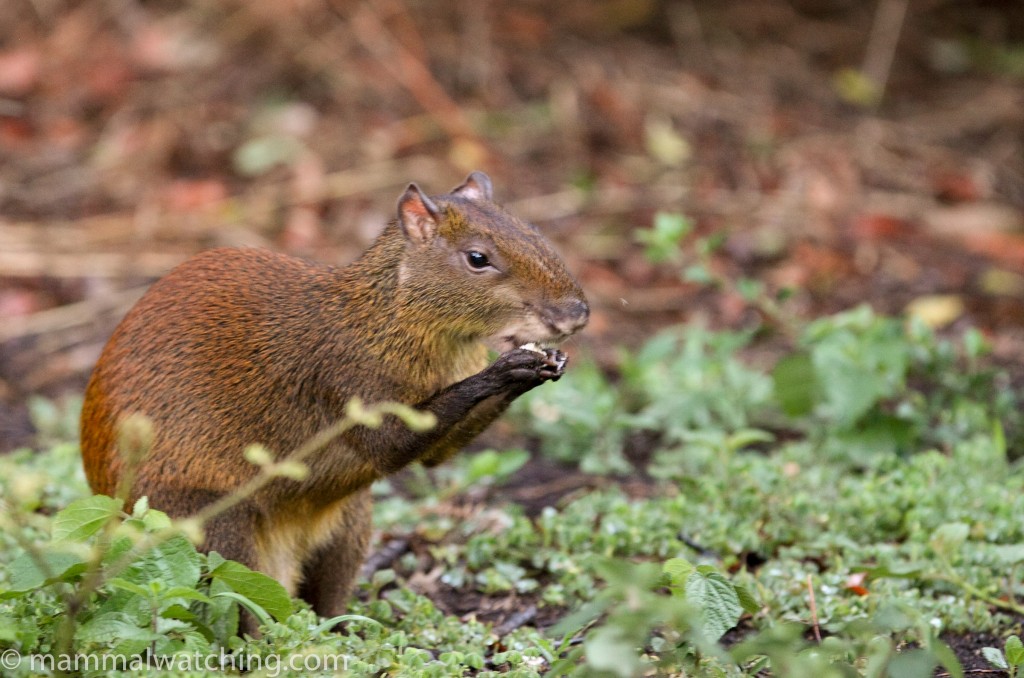
Central American Agouti, Dasyprocta punctata
Santa Rosa National Park
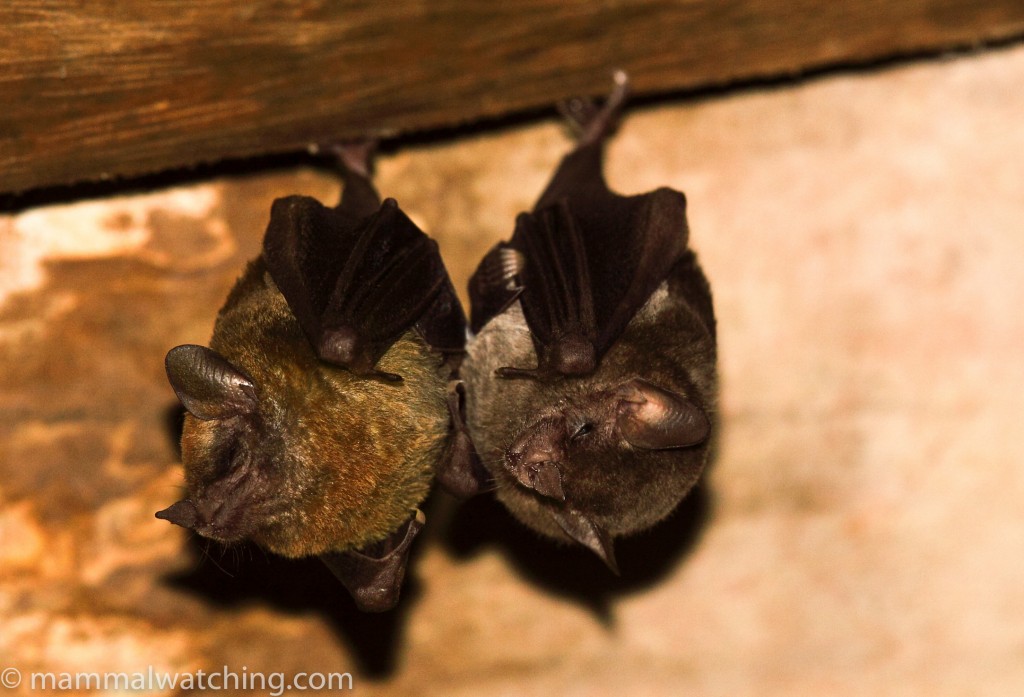
Seba’s Short-tailed Fruit Bats, Carollia perspicillata
Santa Rosa National Park, half an hour north of Liberia, is one of the largest remaining areas of dry forest in Central America. I had originally intended to spend a few days here but I as I had managed to see most of the Santa Rosa specialities, I changed my plans and just stopped by for a few hours to see some of the bats that roost here.
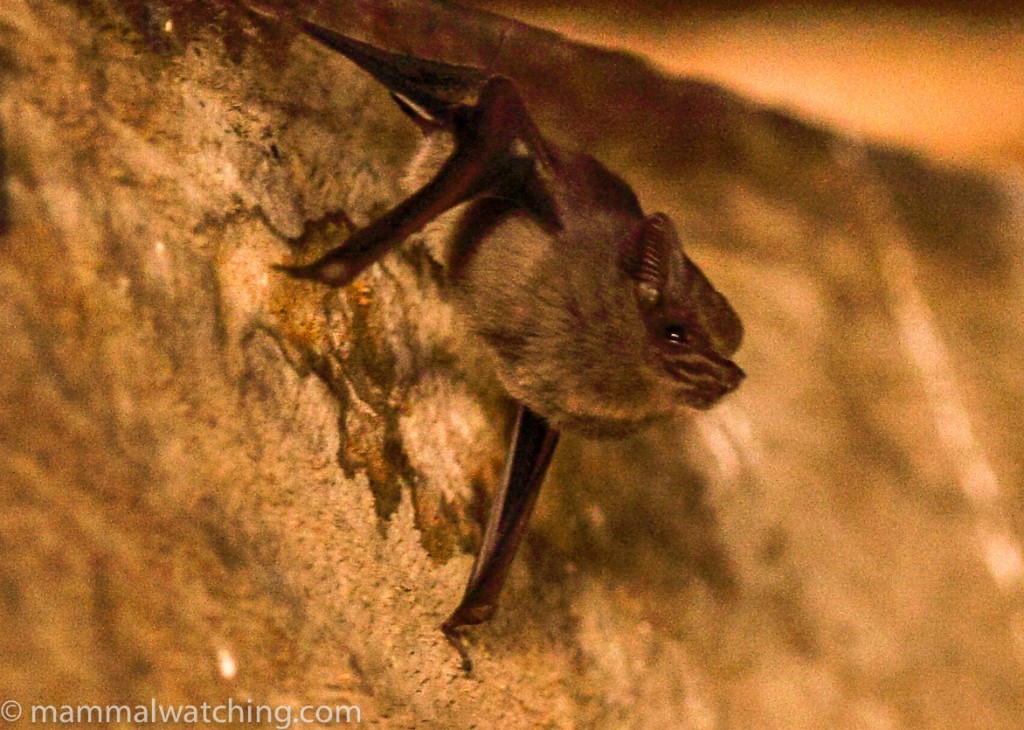
Grey Sac-winged Bat, Balantiopteryx plicata
I picked up Hugo, a local guide, at the entrance station who offered to show me some bat roosts. On the way into the park we visited a hollow tree, five minutes off the trail, which housed a colony of Common Vampire Bats. Photographing them was decidedly unpleasant: when I crawled into the tree, various brown substances started raining down on me and then I was attacked by ants.
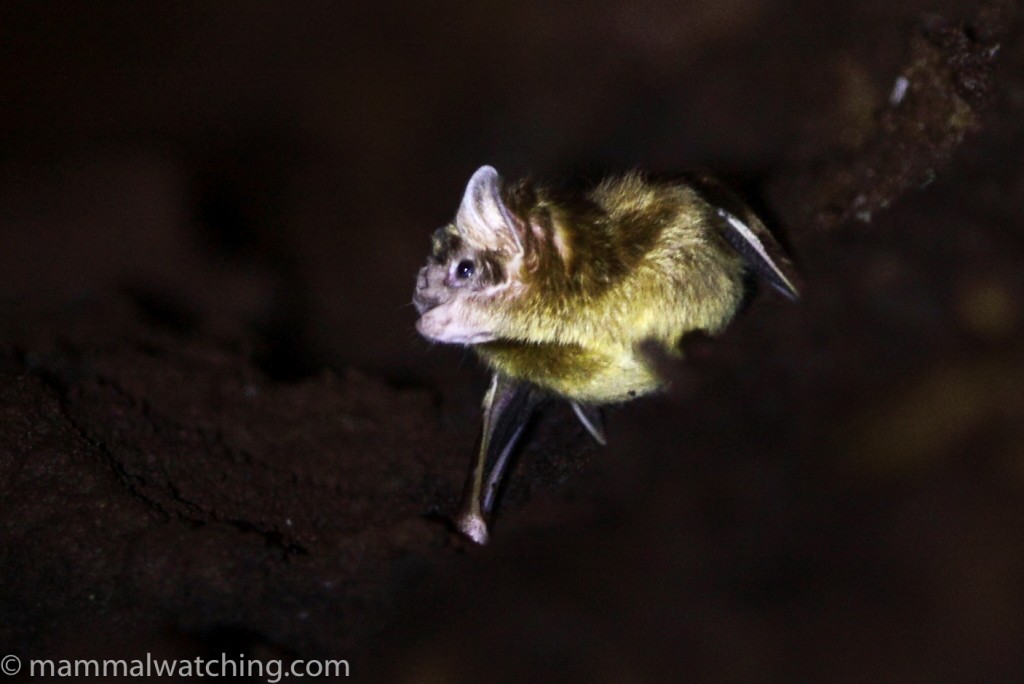
Common Vampire Bat, Desmodus rotundus
Several species of bats were roosting in a room above the museum at the park HQ. These included a few Greater White-lined Bats, a colony of Grey Sac-winged Bats (Balantiopteryx plicata) most of which were banded, a couple of Seba’s Short-tailed Bats (Carollia perspicillata) and another Carollia bat that was strikingly yellow underneath, but may have been another C. perspicillata.
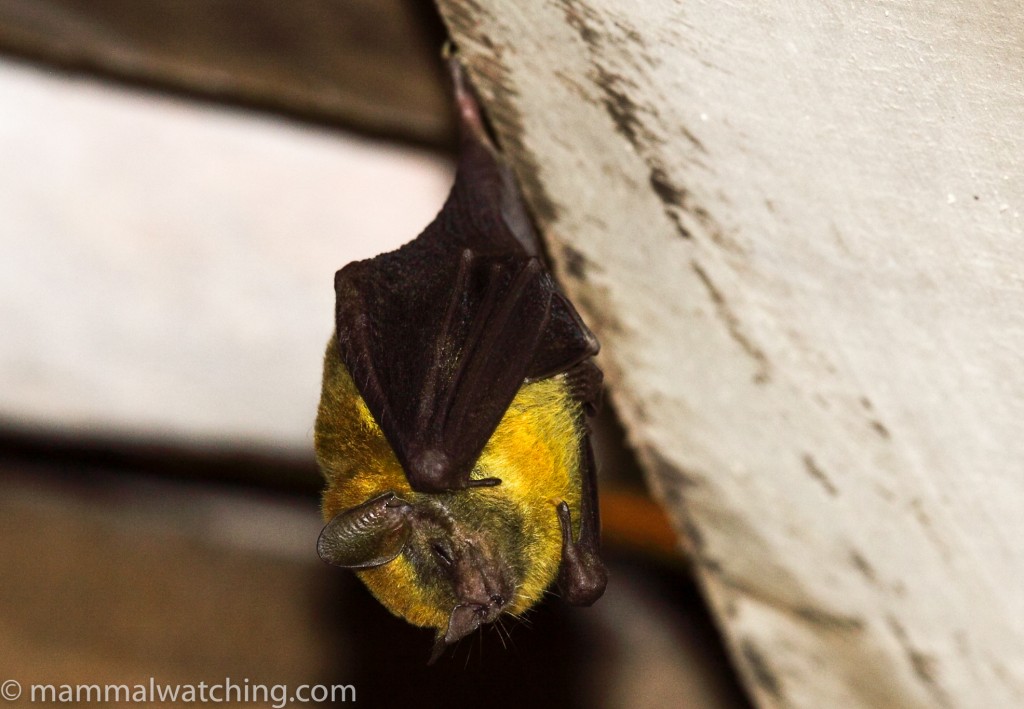
Brightly coloured Carollia
There is a natural bridge about 200m along the Indio Desnudos trail, which starts at the museum. The caves underneath were home to a few bats, most of which wouldn’t sit still except for some Long-tongued bats. Jean Michel Bompar saw Pternotus parnelli and Common Vampire Bats here a few years ago.
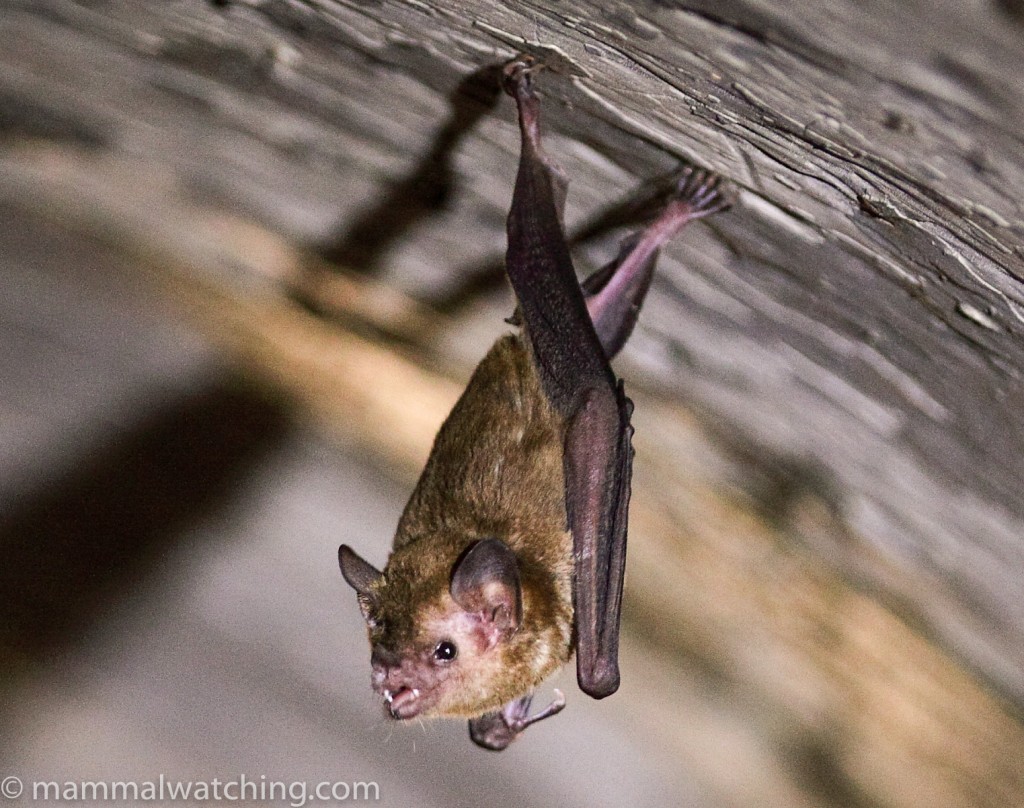
Merriam’s Long-tongued Bat, Glossophaga mutica
Finally, under a culvert along the road into the park we saw some bats which Richard La Val identified as (what is now) a Merriam’s Long-tongued Bat (Glossophaga mutica). I also saw a few Spider Monkeys and heard Howlers while I was there. Hugo said skunks are common at night (presumably Hooded Skunks) and he has seen Pumas and Tayras too, but not often.
On the way back to San Jose I saw one of the black and white race of Variable Squirrels near to Liberia, in a palm tree along the drag through Playa del Cocos, and another in Puntarenas where I spent my last night.
My last night had one final adventure with my first Costa Rican sightingof Homo sapiens pettythiefii: I woke up at 5 a.m. to see an arm reaching through the bars of my hotel window trying to grab my laptop cable off. I leapt off the bed with a shout and grabbed at the arm. Missed the arm, and smashed another pane of glass. More space to reach through the window for the next night. Puntarenas is a strange place and not recommended.
I should thank several people who helped me with advice before my trip, including Jean Michel Bompar and Jeroen Verhoeff. A special thanks to Richard La Val and Bernal Rodriguez-H for their warm welcome and expert advice while I was there (and since I got back): bat people are the best!
Trip List
Species in bold are lifers
1. Northern Tamandua Tamandua mexicana
2. Silky Anteater Cyclopes dorsalis
3. Hoffmann’s Two-toed Sloth Choloepus hoffmanni
4. Brown-throated Three-toed Sloth Bradypus variegatus
5. Tapiti Sylvilagus brasiliensis
6. Red-tailed Squirrel Sciurus granatensis
7. Variegated Squirrel Sciurus variegatoides
8. Mexican Hairy Dwarf Porcupine Coendou mexicanus
9. Central American Agouti Dasyprocta punctata
10.Tomes’ Spiny Rat Proechimys semispinosus
11. Kinkajou Potos flavus
12. White-nosed Coati Nasua narica
13. Proboscis Bat Rhynchonycteris naso
14. Thomas’s Shaggy Bat Centronycteris centralis
15. Gray Sac-winged Bat Balantiopteryx plicata
16. Greater White-lined Bat Saccopteryx bilineata
17. Lesser White-lined Bat Saccopteryx leptura
18. Chestnut Sac-winged Bat Cormura brevirostris
19. Lesser Dog-like Bat Peropteryx macrotis
20. Hairy Big-eared Bat Micronycteris hirsuta
21. Greater Spear-nosed Bat Phyllostomus hastatus
22. Merriam’s Long-tongued Bat Glossophaga mutica
23. Seba’s Short-tailed Bat Carollia perspicillata
24. Underwood’s Long-nosed Bat Hylonycteris underwoodi
25. Chestnut Short-tailed Bat Carollia castanea
26. Sowell’s Short-tailed Bat Carollia sowelli
27. Common Tent-making Bat Uroderma convexum
28. Striped Yellow-eared Bat Vampyriscus nymphaea
29. MacConnell’s Bat Mesophylla macconnelli
30 . Honduran White Bat Ectophylla alba
31 . Hairy Big-eyed Bat Chiroderma villosum
32. Intermediate Fruit-eating Bat Artibeus (intermedius) lituratus
33. Jamaican Fruit-eating Bat Artibeus jamaicensis
34. Intermdiate Fruit-eating Bat Artibeus intermedius
35. Great Fruit-eating Bat Artibeus lituratus
36. Thomas’ Fruit-eating Bat Dermanura watsoni
37. Toltec Fruit-eating Bat Dermanura toltecus
38. Common Vampire Bat Desmodus rotundus
39. Mexican Greater Funnel-eared Bat Natalus mexicanus
40. Riparian Myotis Myotis riparius
41 . Central American Squirrel Monkey Saimiri oerstedii
42 . Panamanian White-throated Capuchin Cebus imitator
43. Central American Spider Monkey Ateles geoffroyi
44. Mantled Howler Monkey Alouatta palliata
45. White-lipped Peccary Tayassu pecari
46. Collared Peccary (Javelina) Dicotyles tajacu
47. White-tailed Deer Odocoileus virginianus
48. Baird’s Tapir Tapirus bairdii
Stuff I Missed
Costa Rica is an exceptionally good place to look for mammals. The variety of habitats in a strong network of protected areas, and the number of guides walking the trails looking for wildlife all add up to good mammal watching. Before I arrived I had hoped that I might see 25 new species, but I ended up with 37 lifers among almost 50 species in a little over a week in the field. Except for the Olingo, I saw all of the species I really hoped to see, namely: Baird’s Tapir, White-lipped Peccary, Silky Anteater and Mexican Porcupine, the four primates and two sloths. And most of these were easy to see in the right places. I also saw many more bats than I was expecting including some really nice species.
I was always on the lookout for Tayras, which I thought there was a good chance of bumping into, and a Margay or Jaguarundi, which I thought there was a remote chance of bumping into, but I wasn’t trying to see these particularly. So don’t be like me and wait 14 years before going to Costa Rica!


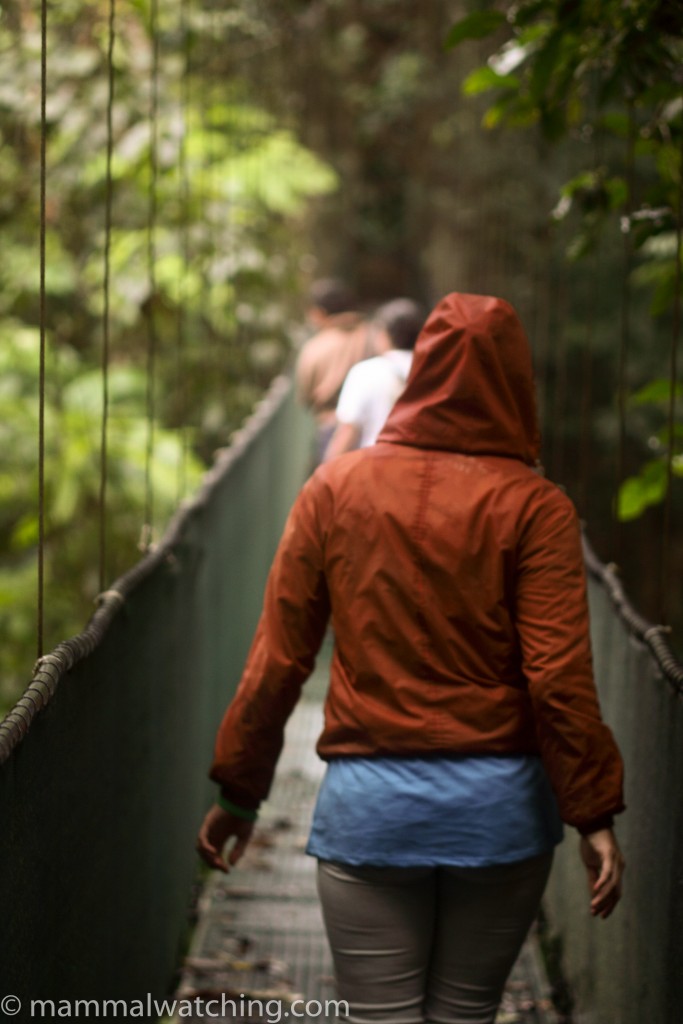
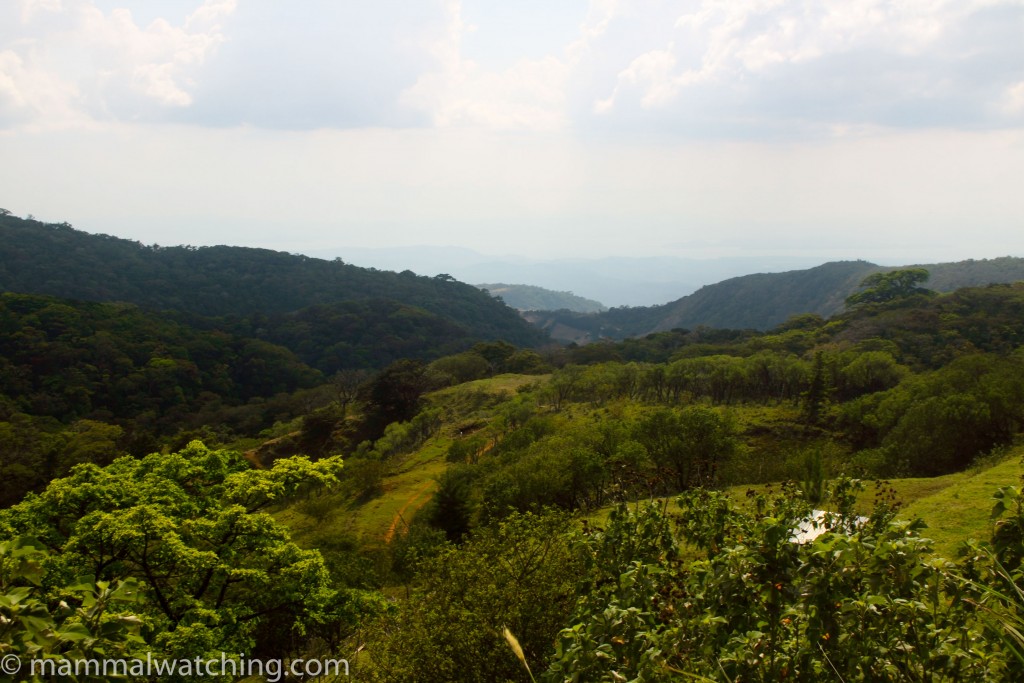
Leave a Reply
You must be logged in to post a comment.